Home Blog Presentation Ideas How to Start a Presentation: 5 Strong Opening Slides and 12 Tricks To Test

How to Start a Presentation: 5 Strong Opening Slides and 12 Tricks To Test

Knowing how to start a presentation is crucial: if you fail to capture the audience’s attention right off the bat, your entire presentation will flop. Few listeners will stick with you to the end and retain what you have told.
That is mildly unpleasant when you are doing an in-house presentation in front of your colleagues. But it can become utterly embarrassing when you present in front of larger audiences (e.g., at a conference) or worse – delivering a sales presentation to prospective customers.
Here is how most of us begin a presentation: give an awkward greeting, thank everyone for coming, clear our throats, tap the mic, and humbly start to mumble about our subject. The problem with such an opening performance? It effectively kills and buries even the best messages.
Table of Contents
- The Classic Trick: Open a Presentation with an Introduction
- Open a Presentation with a Hook
- Begin with a Captivating Visual
- Ask a “What if…” Question
- Use the Word “Imagine”
- Leverage The Curiosity Gap
- The Power of Silence
- Facts as Weapons of Communication
- Fact vs. Myths
- The Power of Music
- Physical Activity
- Acknowledging a Person
How to Start a PowerPoint Presentation The Right Way
Let’s say you have all of your presentation slides polished up (in case you don’t, check our quick & effective PowerPoint presentation design tips first). Your presentation has a clear storyline and agenda. Main ideas are broken into bite-sized statements for your slides and complemented with visuals. All you have left is to figure out how you begin presenting.
The best way is to appeal to and invoke certain emotions in your audience – curiosity, surprise, fear, or good old amusements. Also, it is recommended to present your main idea in the first 30 seconds of the presentation. And here’s how it’s done.
1. The Classic Trick: Open a Presentation with an Introduction

When you don’t feel like reinventing the wheel, use a classic trick from the book – start with a quick personal introduction. Don’t want to sound as boring as everyone else with your humble “Hi, I’m John, the head of the Customer Support Department”? Great, because we are all about promoting effective presentation techniques (hint: using a dull welcome slide isn’t one of them).
Here’s how to introduce yourself in a presentation the right way.
a. Use a link-back memory formula
To ace a presentation, you need to connect with your audience. The best way to do so is by throwing in a simple story showing who you are, where you came from, and why your words matter.
The human brain loves a good story, and we are more inclined to listen and retain the information told this way. Besides, when we can relate to the narrator (or story hero), we create an emotional bond with them, and, again – become more receptive, and less skeptical of the information that is about to be delivered.
So here are your presentation introduction lines:
My name is Joanne, and I’m the Head of Marketing at company XYZ. Five years ago I was working as a waitress, earning $10/hour and collecting rejection letters from editors. About ten letters every week landed to my mailbox. You see, I love words, but decent publisher thought mine were good enough. Except for the restaurant owner. I was very good at up-selling and recommending dishes to the customers. My boss even bumped my salary to $15/hour as a token of appreciation for my skill. And this made me realize: I should ditch creative writing and focus on copywriting instead. After loads of trial and error back in the day, I learned how to write persuasive copy. I was no longer getting rejection letters. I was receiving thousands of emails saying that someone just bought another product from our company. My sales copy pages generated over $1,500,000 in revenue over last year. And I want to teach you how to do the same”
b. Test the Stereotype Formula
This one’s simple and effective as well. Introduce yourself by sharing an obvious stereotype about your profession. This cue will help you connect with your audience better, make them chuckle a bit, and set a lighter mood for the speech to follow.
Here’s how you can frame your intro:
“My name is ___, and I am a lead software engineer at our platform [Your Job Title]. And yes, I’m that nerdy type who never liked presenting in front of large groups of people. I would rather stay in my den and write code all day long. [Stereotype]. But hey, since I have mustered enough courage…let’s talk today about the new product features my team is about to release….”
After sharing a quick, self-deprecating line, you transition back to your topic, reinforcing the audience’s attention . Both of these formulas help you set the “mood” for your further presentation, so try using them interchangeably on different occasions.
2. Open a Presentation with a Hook
Wow your audience straight off the bat by sharing something they would not expect to hear. This may be one of the popular first-time presentation tips but don’t rush to discard it.
Because here’s the thing: psychologically , we are more inclined to pay attention whenever presented with an unexpected cue. When we know what will happen next – someone flips the switch, and lights turn on – we don’t really pay much attention to that action.
But when we don’t know what to expect next – e.g., someone flips the switch and a bell starts ringing – we are likely to pay more attention to what will happen next. The same goes for words: everyone loves stories with unpredictable twists. So begin your presentation with a PowerPoint introduction slide or a line that no one expects to hear.
Here are a few hook examples you can swipe:
a. Open with a provocative statement
It creates an instant jolt and makes the audience intrigued to hear what you are about to say next – pedal back, continue with the provocation, or do something else that they will not expect.

“You will live seven and a half minutes longer than you would have otherwise, just because you watched this talk.”
That’s how Jane McGonigal opens one of her TED talks . Shocking and intriguing, right?
b. Ask a rhetorical, thought-provoking question
Seasoned presenters know that one good practice is to ask a question at the beginning of a presentation to increase audience engagement. Rhetorical questions have a great persuasive effect – instead of answering aloud, your audience will silently start musing over it during your presentation. They aroused curiosity and motivated the audience to remain attentive, as they did want to learn your answer to this question.
To reinforce your message throughout the presentation, you can further use the Rhetorical Triangle Concept – a rhetorical approach to building a persuasive argument based on Aristotle’s teachings.
c. Use a bold number, factor stat
A clean slide with some mind-boggling stat makes an undeniably strong impact. Here are a few opening statement examples you can use along with your slide:
- Shock them: “We are effectively wasting over $1.2 billion per year on producing clothes no one will ever purchase”
- Create empathy: “Are you among the 20% of people with undiagnosed ADHD?”
- Call to arms: “58% of marketing budgets are wasted due to poor landing page design. Let’s change this!”
- Spark curiosity: “Did you know that companies who invested in speech recognition have seen a 13% increase in ROI within just 3 years?”
3. Begin with a Captivating Visual
Compelling visuals are the ABC of presentation design – use them strategically to make an interesting statement at the beginning and throughout your presentation. Your first presentation slide can be text-free. Communicate your idea with a visual instead – a photo, a chart, an infographic, or another graphics asset.
Visuals are a powerful medium for communication as our brain needs just 13 milliseconds to render what our eyes see, whereas text comprehension requires more cognitive effort.
Relevant images add additional aesthetic appeal to your deck, bolster the audience’s imagination, and make your key message instantly more memorable.
Here’s an intro slide example. You want to make a strong presentation introduction to global pollution. Use the following slide to reinforce the statement you share:

“Seven of nine snow samples taken on land in Antarctica found chemicals known as PFAs, which are used in industrial products and can harm wildlife”
Source: Reuters
4. Ask a “What if…” Question
The “what if” combo carries massive power. It gives your audience a sense of what will happen if they choose to listen to you and follow your advice. Here are a few presentations with starting sentences + slides to illustrate this option:

Alternatively, you can work your way to this point using different questions:
- Ask the audience about their “Why.” Why are they attending this event, or why do they find this topic relevant?
- Use “How” as your question hook if you plan to introduce a potential solution to a problem.
- If your presentation has a persuasion factor associated, use “When” as a question to trigger the interest of the audience on, for example, when they are planning to take action regarding the topic being presented (if we talk about an inspirational presentation).

5. Use the Word “Imagine”
“Imagine,” “Picture This,” and “Think of” are better word choices for when you plan to begin your presentation with a quick story.
Our brain loves interacting with stories. In fact, a captivating story makes us more collaborative. Scientists have discovered that stories with tension during narrative make us:
- Pay more attention,
- Share emotions with the characters and even mimic the feelings and behaviors of those characters afterward.
That’s why good action movies often feel empowering and make us want to change the world too. By incorporating a good, persuasive story with a relatable hero, you can also create that “bond” with your audience and make them more perceptive to your pitch – donate money to support the cause; explore the solution you are offering, and so on.
6. Leverage The Curiosity Gap
The curiosity gap is another psychological trick frequently used by marketers to solicit more clicks, reads, and other interactions from the audience. In essence, it’s the trick you see behind all those clickbait, Buzzfeed-style headlines:

Not everyone is a fan of such titles. But the truth is – they do the trick and instantly capture attention. The curiosity gap sparks our desire to dig deeper into the matter. We are explicitly told that we don’t know something important, and now we crave to change that. Curiosity is an incredibly strong driving force for action – think Eve, think Pandora’s Box.
So consider incorporating these attention grabbers for your presentation speech to shock the audience. You can open with one, or strategically weave them in the middle of your presentation when you feel like your audience is getting tired and may lose their focus.
Here’s how you can use the curiosity gap during your presentation:
- Start telling a story, pause in the middle, and delay the conclusion of it.
- Withhold the key information (e.g., the best solution to the problem you have described) for a bit – but not for too long, as this can reduce the initial curiosity.
- Introduce an idea or concept and link it with an unexpected outcome or subject – this is the best opening for a presentation tip.
7. The Power of Silence
What would you do if you attended a presentation in which the speaker remains silent for 30 seconds after the presentation starts? Just the presenter, standing in front of the audience, in absolute silence.
Most likely, your mind starts racing with thoughts, expecting something of vital importance to be disclosed. The surprise factor with this effect is for us to acknowledge things we tend to take for granted.
It is a powerful resource to introduce a product or to start an inspirational presentation if followed by a fact.
8. Facts as Weapons of Communication
In some niches, using statistics as the icebreaker is the best method to retain the audience’s interest.
Say your presentation is about climate change. Why not introduce a not-so-common fact, such as the amount of wool that can be produced out of oceanic plastic waste per month? And since you have to base your introduction on facts, research manufacturers that work with Oceanic fabrics from recycled plastic bottles .
Using facts helps to build a better narrative, and also gives leverage to your presentation as you are speaking not just from emotional elements but from actually recorded data backed up by research.
9. Fact vs. Myths
Related to our previous point, we make quite an interesting speech if we contrast a fact vs. a myth in a non-conventional way: using a myth to question a well-accepted fact, then introducing a new point of view or theory, backed on sufficient research, that proves the fact wrong. This technique, when used in niches related to academia, can significantly increase the audience’s interest, and it will highlight your presentation as innovative.
Another approach is to debunk a myth using a fact. This contrast immediately piques interest because it promises to overturn commonly held beliefs, and people naturally find it compelling when their existing knowledge is put to the test. An example of this is when a nutritionist wishes to speak about how to lose weight via diet, and debunks the myth that all carbohydrates are “bad”.
10. The Power of Music
Think about a presentation that discusses the benefits of using alternative therapies to treat anxiety, reducing the need to rely on benzodiazepines. Rather than going technical and introducing facts, the presenter can play a soothing tune and invite the audience to follow an exercise that teaches how to practice breathing meditation . Perhaps, in less than 2 minutes, the presenter can accomplish the goal of exposing the advantages of this practice with a live case study fueled by the proper ambiance (due to the music played in the beginning).
11. Physical Activity
Let’s picture ourselves in an in-company presentation about workspace wellness. For this company, the sedentary lifestyle their employees engage in is a worrying factor, so they brought a personal trainer to coach the employees on a basic flexibility routine they can practice in 5 minutes after a couple of hours of desk time.
“Before we dive in, let’s all stand up for a moment.” This simple instruction breaks the ice and creates a moment of shared experience among the attendees. You could then lead them through a brief stretching routine, saying something like, “Let’s reach up high, and stretch out those muscles that get so tight sitting at our desks all day.” With this action, you’re not just talking about workplace wellness, you’re giving them a direct, personal experience of it.
This approach has several advantages. Firstly, it infuses energy into the room and increases the oxygen flow to the brain, potentially boosting the audience’s concentration and retention. Secondly, it sets a precedent that your presentation is not going to be a standard lecture, but rather an interactive experience. This can raise the level of anticipation for what’s to come, and make the presentation a topic for future conversation between coworkers.
12. Acknowledging a Person
How many times have you heard the phrase: “Before we begin, I’d like to dedicate a few words to …” . The speaker could be referring to a mentor figure, a prominent person in the local community, or a group of people who performed charity work or obtained a prize for their hard work and dedication. Whichever is the reason behind this, acknowledgment is a powerful force to use as a method of starting a presentation. It builds a connection with the audience, it speaks about your values and who you admire, and it can transmit what the conversation is going to be about based on who the acknowledged person is.
Closing Thoughts
Now you know how to start your presentation – you have the opening lines, you have the slides to use, and you can browse even more attractive PowerPoint presentation slides and templates on our website. Also, we recommend you visit our article on how to make a PowerPoint Presentation to get familiarized with the best tactics for professional presentation design and delivery, or if you need to save time preparing your presentation, we highly recommend you check our AI Presentation Maker to pair these concepts with cutting-edge slide design powered by AI.

Like this article? Please share
Curiosity Gap, Opening, Public Speaking, Rhetorical Triangle, Speech, What If Filed under Presentation Ideas
Related Articles

Filed under Presentation Ideas • September 5th, 2023
Persuasive Speech: Actionable Writing Tips and Sample Topics
Business professionals, students, and others can all benefit from learning the principles of persuasive speech. After all, the art of persuasion can be applied to any area of life where getting people to agree with you is important. In this article, we get into the basics of persuasive speaking, persuasive speech writing, and lastly persuasive speech topics.

Filed under Presentation Ideas • August 5th, 2023
How Parkinson’s Law Can Make Your Presentations Better
Sometimes even the best presenters procrastinate their work until the very last moment. And then, suddenly, they get a flow of ideas to complete their slide deck and present like they have been preparing for it for ages. However, doing so has drawbacks, as even professional presenters cannot always elude the side effects of […]

Filed under Presentation Ideas • April 29th, 2022
How to Become Great in Public Speaking: Presenting Best Practices
Public Speaking takes a lot of practice and grit, however, it also requires a method that can help you through your presentation. Explore more about this subject in this blog post.
5 Responses to “How to Start a Presentation: 5 Strong Opening Slides and 12 Tricks To Test”
I love to follow the ideas, it’s good for a freshman
Leave a Reply
10 Strong Opening Slides to Start A Presentation (With Examples!)
Hrideep barot.
- Presentation

It is weird how now that we all live on our laptops and depend on them for entertainment and livelihood, things that shock us aren’t that many. This is a big itchy spot when it comes to engaging audiences and having a killer opening.
Lets focus on getting that perfect first slide in your presentation to help you kick off on the right foot.
How to open presentations
Opening presentations is an extremely daunting task. The worry of putting your best foot forward but at the same time not coming across as arrogant and the whole issue with fanning your armpits just before you step on the stage.
Yeah, I know. I relate, I think most of us do. We have braved those sweat patches and we have conquered.
It is time to up our opening game and while I will be getting to the ways we can do that, you can also check out this video for a quick idea.
What should be the first slide of a presentation?
Your first slide, needs to be impactful, with minimal content. An extremely difficult balance to maintain, but! Not impossible.
Your first slide, traditionally, is your name, the topic you are going to speak on and maybe on or two other details with MAYBE an image or some other graphics.
Gone are the days when we open speeches or presentations the traditional way, nothing wrong with it, but doing something “not normal” often helps us get people’s attention and that is the easiest way to get your points across and have them received positively.
Let’s check out a few ways you can open slides for a strong opening!
Strong Opening Slide Ideas
We’ve got our thinking cap on, let’s get cracking!
There are so many ways we can have a strong opening, even when you think presentations limit you.
Think of it this way, because people know you’re going to presenting something, they are going to give you full control of a projector. A big ass screen for all to see. If that isn’t filled with potential, I don’t know what is.
Well, with great power comes great responsibility, so let’s check out a few ways we can have killer opening slides , while of course being responsible… ish.
Idea 1: Introduction
There is no better way to get the audience to remember you than putting a giant photo of yourself on the screen and going, this is me, – an extremely edited version of me, but still, me. 🙂
Buddy. No. That was an attempt at being the funny – clever person. Clearly it didn’t work.
Don’t get me wrong, talking about yourself is good, important even to some extent, but that is it you see, it isn’t the fact that you’re talking about yourself that is the problem but what are you talking about that is.
The usual go to is to list out your biodata for the audience to read on the screen, while you speak the exact same thing off of the presentation. This is where we go wrong, no one wants to know about all your seven Ph.Ds. Bruce. (get the reference please)
Be proud of your qualifications, you earned them, but know when and where which qualification might be useful.
For example, you are a certified chartered accountant and have written plays that were on Broadway. In a screenwriting workshop / panel / seminar, as great as getting your chartered accountancy is, your experience as a writer holds way more value and is what will help you get the audience’s attention.
Let’s create an opening slide with the above example.

I used these polaroid photo ideas because for a play on Broadway, we’d love to see pictures! You can use tasteful pictures and even stock photos to help your audience get the right idea of your background.
Of course, I used these random paper elements to give it a more “writer” feel and also because this is my aesthetic, but you need to remember that this is your presentation and no cookie cutter mould will work. Even templates are meant to be edited to suit your needs.
Idea 2: Quiz
Is this to make your audience feel dumb? As much as that chaotic evil side of you may want to. Never do that. Respect their experiences as much as you would want them to respect yours.
Starting off with a quiz is a great way to warm up the crowd and get them involved in your presentation. Give them something to think about and it honestly doesn’t matter if they get it right or wrong, what matters is that they are trying to answer and interact!

Quizzes are a great ice breaker and also a great tool to get the audience going, you can also try to have a one off question or a series of questions.
Lets take the slide as an example, it could be for a presentation on a film industry and the question could be, guess the film from these three pictures, or they could be three different questions.
Remember as an opening slide, it should neither be text nor image heavy, just the right amount.
You could even create a game out of those quizzes and have checked off your list and even use these as a starting off point and come back to the topics (which could be your answers) while using this quiz as a reference point. The possibilities are endless!
Idea 3: Stimulation of Imagination
It always great to know what your audience is thinking, or in the least get them thinking!
You see, once they start thinking, they begin forming an opinion about the topic, which gets them invested and since you are the person addressing the topic, they will begin comparing their point of view / opinion with what they are saying.
There will always be different perspectives, what matters here is that they are invested enough to pay attention to you.
A really easy way to help them get started with forming an opinion is, asking them to take a minute to think about something.
For example: Think about a dancing monkey.
Can some of you describe the monkey you imagined, in the comment section? Was it wearing tap shoes and a top hat? Was it wearing a marching band uniform? Did it have your best friend’s face on it? Mine did!
Each of you had your own Dancing Monkey, and if thinking about it for a few seconds made it your own, imagine the attachment you can build by just spending a few minutes or even the duration of a presentation on it!

For example, you’re taking a presentation on perspectives or psychology. You can display this image and ask them what they think of it. Some may think about freedom, some loneliness and some people’s thoughts may be so profound that we could’ve never thought of it!
Idea 4: Video
This could work just as marvellous as sharing an image and opening a short discussion on its interpretations. You could even start with a video and use it as a segue into your presentation.
For example this video could be used as a great example for a marketing strategy by the brand and could be a great way to get the audience interested given the emotional quotient and relatable sibling content.
Idea 5: Image
Using an image might not necessarily mean that you can only invite the audience to imagine and think on their own. You can use an image to start your presentation and help get your point across.

You see that how the image is the hero of the slide? There is text, definitely, but much smaller, it looks as a complementary to the image instead of the other way around.
In this slide for example, assume poverty is the topic, a very telling image of poverty could help get the conversation started and make the audience more receptive of the topic.
An image in a way helps them “put a face” to the issue and that makes is easier for you to hold their attention and keep it.
Idea 6: Quote
It is well known and understood how impactful the right quote at the right time can be.
Lets focus on some things that people can often get wrong when using quotes.
Firstly, using long quotes, this is a no no when it comes to presentations because, then the audience will be in a rush to read the whole quote and if your point is made before then, well, we won’t get the desired effect will we?
Another thing to keep in mind is to not have a quote just to use it as a quote, pretty cryptic, honestly it is simple, if you are giving a presentation on a person and using their quote or you are using a random quote, make sure to have something to add to it.
It could be something simple. For example when talking about a person’s life:
“When this person said this, they were on their death bed, but they had lead a vivacious life until then to say the least, let’s start at the very beginning…”

Notice how despite there being a background picture, a text box, a bird in the corner, and all that, the text is what is the hero of the slide. You could even add a picture of the person whom you are quoting if it seems relevant.
Remember to always give credit where it is due. It never hurts.
Idea 7: Story
Who doesn’t love a good story? Storytelling is a major part of public speaking where animation, emotion and gestures and tones play a huge role in delivering your point.
With presentations, you need to remember to not just select any story, you need find / write a story that connects well to your topic, for example, if we are speaking about technology, a story about Alice and her looking glass don’t really give you much room to work in a segue.
Storytelling is a whole other conversation, check out this article to learn more about public speaking and how storytelling factors into it: Public Speech Into Story: 3 Steps To Telling A Captivating Story

Here the pictures are the heroes, and while words are important, make them complementary to what you are speaking.
Starting off with a joke is also a very popular trick and I think why should it be this or that, why should it be a joke or a story, why can’t it be a humorous story?
Now don’t go fretting about because it doesn’t have to be fictional, it could even be an anecdote from your experiences or maybe one comic strip you found online.
When it comes to humorous speeches, it can be quite intimidating, but here is an article I think will help you wade through these waters: A Guide To Using Humour In Your Speech
Idea 8: Examples
This is a great way to introduce your topic to a crowd that doesn’t know your topic well. Create examples or situations to help your audience gain a smooth entry into your presentation.
It is like math, it is fun when you understand, and that means you care and give attention to it.
You can also use case studies or make your examples into stories to make it more subtle and seamless.

Here is where a traditional topic, sentence and image layout of an opening slide is best suggested. You can build this in any direction and still be able to relate to your slide.
Idea 9: Hard Facts
Facing facts instances that are always either pleasantly welcomed or hard to swallow. Hitting the audience with hard facts works really well, especially if what you are going to talk about is a difficult or sensitive issue.
An astonishing fact is bound to catch people’s attention and you can always use it to your advantage!
According to Femme International, over the last 20 years, the sanitary pad sector has bloomed and advanced; they have taken over the industry and 85% of menstruating women in the country use napkins. As society progressed and the taboo on periods were lifted from many regions, a new problem came up. One which is really harmful. We all know that the blood that comes out during our periods is harmful and full of bacteria. Now include this bacteria filled blood with a pad which takes 500-800 years to decompose. That’s right, 500-800 years of a used sanitary napkin breeding bacteria in rivers, drains, soil and the sea. A menstruating woman uses 15-20 pads for one cycle. Which sums up to 7,200-9,600 pads over an average period of 40 years. This is just for one woman. According to UNICEF roughly 26% of the world’s population are menstruating women. This means that 2.28 BILLION women are going to use over 9,000 pads EACH during their menstruating years.

Always try to not keep your introductory slides text heavy, but when starting with facts, try to highlight them, notice how the topic and the image are not very prominent but play their part in bringing together the entire slide while the first thing you read is the fact, underlined and set in the middle.
Try to play around with the layouts, figure out what suits your needs the best.
Idea 10: Controversial Statements
Who doesn’t love controversies?
Even if we know something is clickbait, it still catches our eye. Even if we know something to not be possible, when someone says it – with conviction, our ears do perk up.
It doesn’t have to be something extraordinary, just not ordinary enough that it catches people’s attention and in the end, you can always use it to connect your conclusion to your introduction.
Here is a great TEDTalk that would help you understand what I am talking about.
If you plan to use this method, it is easier to dive into your slides after you’ve made the statement and start elaborating on it instead of right at the beginning, it could start with your topic or some proof or where ever your presentation takes you!
Final Thoughts
A presentation carries as much personality as its maker, if you want the right impact you need to use the templates, infographics and tools available to you to the fullest, but remember, there is a thing called “too much” as well.
The easiest way to kill it with your presentations is to keep it neat, in your aesthetic and to the point. Make it engaging, make it colourful, make it black and white. It would work perfectly if it bounces off your personality on stage.
Enroll in our transformative 1:1 Coaching Program
Schedule a call with our expert communication coach to know if this program would be the right fit for you

8 Ways to Rise Above the Noise to Communicate Better

How to Negotiate: The Art of Getting What You Want

10 Hand Gestures That Will Make You More Confident and Efficient

- [email protected]
- +91 98203 57888
Get our latest tips and tricks in your inbox always
Copyright © 2023 Frantically Speaking All rights reserved
Kindly drop your contact details so that we can arrange call back
Select Country Afghanistan Albania Algeria AmericanSamoa Andorra Angola Anguilla Antigua and Barbuda Argentina Armenia Aruba Australia Austria Azerbaijan Bahamas Bahrain Bangladesh Barbados Belarus Belgium Belize Benin Bermuda Bhutan Bosnia and Herzegovina Botswana Brazil British Indian Ocean Territory Bulgaria Burkina Faso Burundi Cambodia Cameroon Canada Cape Verde Cayman Islands Central African Republic Chad Chile China Christmas Island Colombia Comoros Congo Cook Islands Costa Rica Croatia Cuba Cyprus Czech Republic Denmark Djibouti Dominica Dominican Republic Ecuador Egypt El Salvador Equatorial Guinea Eritrea Estonia Ethiopia Faroe Islands Fiji Finland France French Guiana French Polynesia Gabon Gambia Georgia Germany Ghana Gibraltar Greece Greenland Grenada Guadeloupe Guam Guatemala Guinea Guinea-Bissau Guyana Haiti Honduras Hungary Iceland India Indonesia Iraq Ireland Israel Italy Jamaica Japan Jordan Kazakhstan Kenya Kiribati Kuwait Kyrgyzstan Latvia Lebanon Lesotho Liberia Liechtenstein Lithuania Luxembourg Madagascar Malawi Malaysia Maldives Mali Malta Marshall Islands Martinique Mauritania Mauritius Mayotte Mexico Monaco Mongolia Montenegro Montserrat Morocco Myanmar Namibia Nauru Nepal Netherlands Netherlands Antilles New Caledonia New Zealand Nicaragua Niger Nigeria Niue Norfolk Island Northern Mariana Islands Norway Oman Pakistan Palau Panama Papua New Guinea Paraguay Peru Philippines Poland Portugal Puerto Rico Qatar Romania Rwanda Samoa San Marino Saudi Arabia Senegal Serbia Seychelles Sierra Leone Singapore Slovakia Slovenia Solomon Islands South Africa South Georgia and the South Sandwich Islands Spain Sri Lanka Sudan Suriname Swaziland Sweden Switzerland Tajikistan Thailand Togo Tokelau Tonga Trinidad and Tobago Tunisia Turkey Turkmenistan Turks and Caicos Islands Tuvalu Uganda Ukraine United Arab Emirates United Kingdom United States Uruguay Uzbekistan Vanuatu Wallis and Futuna Yemen Zambia Zimbabwe land Islands Antarctica Bolivia, Plurinational State of Brunei Darussalam Cocos (Keeling) Islands Congo, The Democratic Republic of the Cote d'Ivoire Falkland Islands (Malvinas) Guernsey Holy See (Vatican City State) Hong Kong Iran, Islamic Republic of Isle of Man Jersey Korea, Democratic People's Republic of Korea, Republic of Lao People's Democratic Republic Libyan Arab Jamahiriya Macao Macedonia, The Former Yugoslav Republic of Micronesia, Federated States of Moldova, Republic of Mozambique Palestinian Territory, Occupied Pitcairn Réunion Russia Saint Barthélemy Saint Helena, Ascension and Tristan Da Cunha Saint Kitts and Nevis Saint Lucia Saint Martin Saint Pierre and Miquelon Saint Vincent and the Grenadines Sao Tome and Principe Somalia Svalbard and Jan Mayen Syrian Arab Republic Taiwan, Province of China Tanzania, United Republic of Timor-Leste Venezuela, Bolivarian Republic of Viet Nam Virgin Islands, British Virgin Islands, U.S.
PHILADELPHIA, MAY 9-10 PUBLIC SPEAKING CLASS IS ALMOST FULL! RESERVE YOUR SPOT NOW

- Public Speaking Classes
- Corporate Presentation Training
- Online Public Speaking Course
- Northeast Region
- Midwest Region
- Southeast Region
- Central Region
- Western Region
- Presentation Skills
- 101 Public Speaking Tips
- Fear of Public Speaking
How to Introduce Yourself in a Presentation [with Examples]

In this post, we are going to cover the best way, a very simple three-step process that will help you introduce yourself in a presentation. A summary of the steps is below.
- Start with your name and company (or organization or school).
- Tell your audience what problem you can solve for them.
- Share some type of proof (social proof works best) that you can solve this problem.
I will break down each step into a simple-to-follow process. But first… a little background.
First, Identify What Your Audience Wants from Your Presentation

So, before you design your introduction, think about what your audience wants from your presentation. Why do they want to spend their valuable time listening to you? Are going to waste their time? Or, are you going to provide them with something valuable?
For instance, I have expertise in a number of different areas. I’m a public speaking coach, a keynote speaker, a best-selling author, a search engine optimization specialist, and a popular podcaster. However, if I delivered that sentence to any audience, the most likely reaction would be, “So what?” That sentence doesn’t answer any of the above questions. The statement is also really “me-focused” not “audience-focused.”
So, when I start to design my self-introduction, I want to focus just on the area of expertise related to my topic. I’m then going to answer the questions above about that particular topic. Once you have these answers, set them aside for a second. They will be important later.
How to Introduce Yourself in a Presentation in Class.

Instead, you probably want to add in a fun way to start a speech . For example, instead of introducing yourself in your class speech and starting in an awkward way, start with a startling statistic. Or start with a summary of your conclusion. Or, you could start the presentation with an inspirational quote.
Each of these presentation starters will help you lower your nervousness and decrease your awkwardness.
If you are delivering a speech in a speech competition or to an audience who doesn’t know you try this technique. Just introduce yourself by saying your name , the school you represent , and your topic . Make it easy. This way you get to your content more quickly and lower your nervousness.
Typically, after you get the first few sentences out of the way, your nervousness will drop dramatically. Since your name, school, and topic should be very easy to remember, this takes the pressure off you during the most nervous moments.
Obviously, follow the guidelines that your teacher or coach gives you. (The competition may have specific ways they want you to introduce yourself.)
How to Introduce Yourself in a Business Presentation — A Step-by-Step Guide.

In a professional setting, when new people walk into a meeting and don’t know what to expect, they will feel uncomfortable. The easiest way to ease some of that tension is to chat with your audience as they come into the room.
By the way, if you are looking for a template for an Elevator Speech , make sure to click this link.
Step #1: Start with your name and company name (or organization).
This one is easy. Just tell your audience your name and the organization that you are representing. If your organization is not a well-known brand name, you might add a short clarifying description. For instance, most people outside of the training industry have never heard of The Leader’s Institute ®. So, my step #1 might sound something like…
Hi, I’m Doug Staneart with The Leader’s Institute ®, an international leadership development company…
Still short and sweet, but a little more clear to someone who has never heard of my company.
Should you give your job title? Well… Maybe and sometimes. Add your title into the introduction only if your title adds to your credibility.
For example, if you are delivering a financial presentation and you are the Chief Financial Officer (CFO) of your company, you might mention that. Your title adds to your credibility. However, if the CFO is delivering a presentation about the value of joining a trade association, the CFO title adds little credibility. So, there is very little value in adding the title.
Step #2: Tell your audience what problem you can solve for them.

For instance, if my topic is how to deliver presentations, I have to determine why the audience would care. What problem will they have that I can help them with? For my audiences, the problem that I most often help people with is how to eliminate public speaking fear. Once I have the problem, I add that to my introduction by using the words, “I help people…”
Hi, I’m Doug Staneart with The Leader’s Institute ®, an international leadership development company, and I help people eliminate public speaking fear.
However, if my topic is How to Close a Higher Percentage of Sales Presentations , I’d likely want to alter my introduction a little. I might say something like…
Hi, I’m Doug Staneart with The Leader’s Institute ®, an international leadership development company, and I help people design more persuasive sales presentations.
I have expertise in both areas. However, I focus my introduction on just the expertise that is applicable to this audience. If I gave the first introduction to the second audience, they will likely respond by thinking, well, I don’t really get nervous speaking, so I guess I can tune out of this speech .
So, create a problem statement starting with, “I help people…” Make the statement apply to what your audience really wants.
Step #3: Share some type of proof (social proof works best) that you can solve this problem.
By the way, if you just do steps #1 and #2, your introduction will be better than most that you will hear. However, if you add Step #3, you will gain more respect (and attention) from your audience. Without adding some type of proof that you can solve this problem, you are just giving your opinion that you are an expert. However, if you can prove it, you are also proving that you are an expert.
This is the tricky part. For some reason, most people who get to this part feel like they haven’t accomplished great things, so they diminish the great accomplishments that they do have.
For instance, an easy way to offer proof is with a personal story of how you have solved that problem in the past.
A Few Examples of How to Introduce Yourself Before a Presentation.
For instance, one of my early clients was a young accountant. When I was working with him, he came up with the following introduction, “I’m Gary Gorman with Gorman and Associates CPA’s, and I help small businesses avoid IRS audits.” It was a great, audience-focused attention-getter. (No one wants to get audited.) However, as an accountant, it wasn’t like his company was getting a lot of five-star reviews on Yelp! So, he was kind of struggling with his social proof. So, I asked him a series of questions.
Me, “How many clients do you have?”
Gary, “Over 300.”
Me, “How many small business tax returns have you processed?”
Gary, “Well, at least a couple hundred a year for 15 years.”
Me, “So, at least 3000?” He nodded. “How many of your 300 clients have been audited since you have been representing them?”
He looked at me and said, “Well, none.”
So, we just added that piece of proof to his talk of introduction.
I’m Gary Gorman with Gorman and Associates CPA’s, and I help small businesses avoid IRS audits. In fact, in my career, I’ve helped clients complete over 3000 tax returns, and not a single one has ever been audited.
Here Is How I Adjust My Introduction Based on What I Want the Audience to Do.
For my proof, I have a number of options. Just like Gary, I have had a lot of clients who have had great successes. In addition, I have published two best-selling books about public speaking. I also have hundreds of thousands of people who listen to my podcast each week. So, I can pick my evidence based on what I want my audience to do.
For instance, if I’m speaking at a convention, and I want the audience to come by my booth to purchase my books, my introduction might sound like this.
Hi, I’m Doug Staneart with The Leader’s Institute ®, an international leadership development company, and I help people eliminate public speaking fear. One of the things that I’m most know for is being the author of two best-selling books, Fearless Presentations and Mastering Presentations.
However, if I’m leading a webinar, I may want the audience to purchase a seat in one of my classes. In that case, my introduction might sound like this.
Hi, I’m Doug Staneart with The Leader’s Institute ®, an international leadership development company, and I help people eliminate public speaking fear. For instance, for the last 20 years, I’ve taught public speaking classes to over 20,000 people, and I haven’t had a single person fail to reduce their nervousness significantly in just two days.
If my goal is to get the audience to subscribe to my podcast, my intro might sound like…
Hi, I’m Doug Staneart with The Leader’s Institute ®, an international leadership development company, and I help people eliminate public speaking fear. One of the ways that I do this is with my weekly podcast called, Fearless Presentations, which has over one million downloads, so far.
Use the Form Below to Organize How to Introduce Yourself in a Presentation.
The point is that you want to design your introduction in a way that makes people pause and think, “Really? That sounds pretty good.” You want to avoid introductions that make your audience think, “So what?”
If you have a speech coming up and need a good introduction, complete the form below. We will send you your answers via email!
Can You Replace Your Introduction with a PowerPoint Slide?
Is it okay to make your first slide (or second slide) in your presentation slides an introduction? Sure. A good public speaker will often add an introduction slide with a biography, portrait, and maybe even contact information. I sometimes do this myself.
However, I NEVER read the slide to my audience. I often just have it showing while I deliver the short introduction using the guide above. This is a great way to share more of your work experience without sounding like you are bragging.
For tips about how many powerpoint slides to use in a presentation , click here.
Remember that There Is a Big Difference Between Your Introduction in a Presentation and Your Presentation Starter.
When you introduce yourself in a presentation, you will often just use a single sentence to tell the audience who you are. You only use this intro if the audience doesn’t know who you are. Your presentation starter, though, is quite different. Your presentation starter should be a brief introduction with relevant details about what you will cover in your presentation.
For details, see Great Ways to Start a Presentation . In that post, we show ways to get the attention of the audience. We also give examples of how to use an interesting hook, personal stories, and how to use humor to start a presentation.

Podcasts , presentation skills
View More Posts By Category: Free Public Speaking Tips | leadership tips | Online Courses | Past Fearless Presentations ® Classes | Podcasts | presentation skills | Uncategorized
Introduction slide templates (that make you stand out)
Take and use free introduction slide templates for modern professionals. Impress everyone with interactive presentation slides beyond your same-old PowerPoint .

Create story from scratch

Choose template by:
Browse other presentation categories
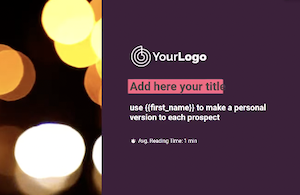
Presentations

Presentation slides
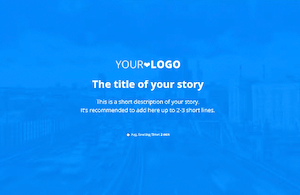
Sales decks
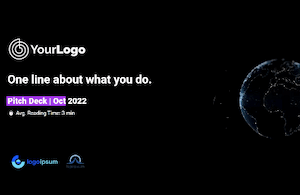
Pitch decks

Proposal decks

Slide decks

Whitepapers
What is an introduction slide?
An introduction slide can mean 1 of 3 things: (1) a slide that gives an overview of the speaker, company, or team giving the presentation. (2) an overview of the project, product, solution, or event covered in the presentation. (3) an overview of the presentation content. The goal of the first use is to establish authority and trust, while the goal of the second and third uses is to establish relevancy and interest.
How to make creative introduction slides?
To get creative with your introduction slides you’ll have to go beyond PowerPoint into the realm of interactive slides. It is very hard to get creative if you’re making a PowerPoint introduction slide. By nature, an introduction slide in ppt is static and therefore severely limited in space and behavior.
How interactive introduction slides make an impact
1. Video intro slide - a video slide is much better at relating with your audience. A living person with a voice, gestures, and expressions adds a layer of non-verbal communication that is critical to establish relatability and trustworthiness.
2. Tabs - Using tabs lets you introduce multiple entities from the same space. You can have a tab for the speaker, the team, leadership, partners, and the company as a whole. You can also segment your intro for different reader personas, with content tailored for each audience.
3. Timeline - Take your readers on a journey through your company or personal history using a timeline slide , and let the reader appreciate each significant moment on its own.
4. Image & text - It’s always better to have a story and a visual to help people make the connection between the two. You can use your photo for a personal intro, your team photo for a team intro, and an image of your company building or logo or recognizable activity for a company intro.
What are the main introduction slide types?
- Self-introduction slide - gives an overview of the speaker or presenter
- Team introduction slide - gives an overview of the team, its expertise, experience, and achievements
- Company introduction slide - gives an overview of the company, its vision, values, and main solutions (sometimes extended to a complete company presentation )
- Project introduction slide - gives an overview of the project, its goals, timeline, key metrics, and deliverables (mostly as part of a project proposal )
- Product introduction slide - gives an overview of the product, its target audience, the problem it solves, and how it will disrupt the market (mostly as part of a product one-pager )
- Webinar introduction slide - gives an overview of the webinar, the topic it covers, who it’s for, what it takes to participate, and when it will take place
Difference between an intro slide, executive introduction, and title slide
An introduction slide is not to be confused with an executive introduction, also called an executive summary slide. Nor should it be confused with the presentation’s title slide.
An intro slide gives an overview of the company, project, product, team, leadership, or person of interest. An executive summary slide gives an introductory overview of the presentation. A title slide is simply the first slide of the presentation.
Create your best presentation to date
Use Storydoc free for 14 days (keep the presentations you make forever!)
We use essential cookies to make Venngage work. By clicking “Accept All Cookies”, you agree to the storing of cookies on your device to enhance site navigation, analyze site usage, and assist in our marketing efforts.
Manage Cookies
Cookies and similar technologies collect certain information about how you’re using our website. Some of them are essential, and without them you wouldn’t be able to use Venngage. But others are optional, and you get to choose whether we use them or not.
Strictly Necessary Cookies
These cookies are always on, as they’re essential for making Venngage work, and making it safe. Without these cookies, services you’ve asked for can’t be provided.
Show cookie providers
- Google Login
Functionality Cookies
These cookies help us provide enhanced functionality and personalisation, and remember your settings. They may be set by us or by third party providers.
Performance Cookies
These cookies help us analyze how many people are using Venngage, where they come from and how they're using it. If you opt out of these cookies, we can’t get feedback to make Venngage better for you and all our users.
- Google Analytics
Targeting Cookies
These cookies are set by our advertising partners to track your activity and show you relevant Venngage ads on other sites as you browse the internet.
- Google Tag Manager
- Infographics
- Daily Infographics
- Template Lists
- Graphic Design
- Graphs and Charts
- Data Visualization
- Human Resources
- Beginner Guides
Blog Marketing
How To Start a Presentation: 15 Ways to Set the Stage
By Krystle Wong , Jul 25, 2023

The opening moments of your presentation hold immense power – it’s your opportunity to make a lasting impression and captivate your audience.
A strong presentation start acts as a beacon, cutting through the noise and instantly capturing the attention of your listeners. With so much content vying for their focus, a captivating opening ensures that your message stands out and resonates with your audience.
Whether you’re a startup business owner pitching a brilliant idea, a seasoned presenter delivering a persuasive talk or an expert sharing your experience, the start of your presentation can make all the difference. But don’t fret — I’ve got you covered with 15 electrifying ways to kickstart your presentation.
The presentation introduction examples in this article cover everything from self-introduction to how to start a group presentation, building anticipation that leaves the audience eager to delve into the depths of your topic.
Click to jump ahead:
How to start a presentation introduction
15 ways to start a presentation and captivate your audience, common mistakes to avoid in the opening of a presentation, faqs on how to start a presentation, captivate the audience from the get-go.

Presentations can be scary, I know. But even if stage fright hits, you can always fall back on a simple strategy.
Just take a deep breath, introduce yourself and briefly explain the topic of your presentation.
To grab attention at the start, try this opening line: Hello everyone. I am so glad you could join me today. I’m very excited about today’s topic. I’m [Your Name] and I’ll be talking about [Presentation Topic]. Raise your hand if you’ve ever felt overwhelmed by [Challenge related to your topic]. Many of us might have faced challenges with [Challenge related to your topic]. Today, we’ll explore some strategies that’ll help us [Solution that you’re presenting].
Regardless of your mode of presentation , crafting an engaging introduction sets the stage for a memorable presentation.
Let’s dive into some key tips for how to start a presentation speech to help you nail the art of starting with a bang:
Understand your audience
The key to an engaging introduction is to know your audience inside out and give your audience what they want. Tailor your opening to resonate with their specific interests, needs and expectations. Consider what will captivate them and how you can make your presentation relevant to their lives or work.
Use a compelling hook
Grab the audience’s attention from the get-go with a compelling hook. Whether it’s a thought-provoking question, a surprising fact or a gripping story, a powerful opening will immediately pique their curiosity and keep them invested in what you have to say.

State your purpose
Be crystal clear about your subject matter and the purpose of your presentation. In just a few sentences, communicate the main objectives and the value your audience will gain from listening to you. Let them know upfront what to expect and they’ll be more likely to stay engaged throughout.
Introduce yourself and your team
Give a self introduction about who you are such as your job title to establish credibility and rapport with the audience.
Some creative ways to introduce yourself in a presentation would be by sharing a brief and engaging personal story that connects to your topic or the theme of your presentation. This approach instantly makes you relatable and captures the audience’s attention.
Now, let’s talk about — how to introduce team members in a presentation. Before introducing each team member, briefly explain their role or contribution to the project or presentation. This gives the audience an understanding of their relevance and expertise.
Group presentations are also a breeze with the help of Venngage. Our in-editor collaboration tools allow you to edit presentations side by side in real-time. That way, you can seamlessly hare your design with the team for input and make sure everyone is on track.
Maintain enthusiasm
Enthusiasm is contagious! Keep the energy levels up throughout your introduction, conveying a positive and upbeat tone. A vibrant and welcoming atmosphere sets the stage for an exciting presentation and keeps the audience eager to hear more.
Before you think about how to present a topic, think about how to design impactful slides that can leave a lasting impression on the audience. Here are 120+ presentation ideas , design tips, and examples to help you create an awesome slide deck for your next presentation.
Captivating your audience from the get-go is the key to a successful presentation. Whether you’re a seasoned speaker or a novice taking the stage for the first time, the opening of your presentation sets the tone for the entire talk.
So, let’s get ready to dive into the 15 most creative ways to start a presentation. I promise you these presentation introduction ideas will captivate your audience, leaving them hanging on your every word.
Grab-attention immediately
Ask a thought-provoking question.
Get the audience’s wheels turning by throwing them a thought-provoking question right out of the gate. Make them ponder, wonder and engage their critical thinking muscles from the very start.
Share a surprising statistic or fact
Brace yourself for some wide eyes and dropped jaws! Open your presentation with a jaw-dropping statistic or a mind-blowing fact that’s directly related to your topic. Nothing captures attention like a good ol’ dose of shock and awe.

State a bold statement or challenge
Ready to shake things up? Kick off with a bold and daring statement that sets the stage for your presentation’s epic journey. Boldness has a way of making ears perk up and eyes widen in anticipation!
Engage with a poll or interactive activity
Turn the audience from passive listeners to active participants by kicking off with a fun poll or interactive activity. Get them on their feet, or rather — their fingertips, right from the start!
Venngage’s user-friendly drag-and-drop editor allows you to easily transform your slides into an interactive presentation . Create clickable buttons or navigation elements within your presentation to guide your audience to different sections or external resources.
Enhance engagement by incorporating videos or audio clips directly into your presentation. Venngage supports video and audio embedding, which can add depth to your content.

Begin with an opening phrase that captures attention
Use opening phrases that can help you create a strong connection with your audience and make them eager to hear more about what you have to say. Remember to be confident, enthusiastic and authentic in your delivery to maximize the impact of your presentation.
Here are some effective presentation starting words and phrases that can help you grab your audience’s attention and set the stage for a captivating presentation:
- “Imagine…”
- “Picture this…”
- “Did you know that…”
- “Have you ever wondered…”
- “In this presentation, we’ll explore…”
- “Let’s dive right in and discover…”
- “I’m excited to share with you…”
- “I have a confession to make…”
- “I want to start by telling you a story…”
- “Before we begin, let’s consider…”
- “Have you ever faced the challenge of…”
- “We all know that…”
- “This is a topic close to my heart because…”
- “Over the next [minutes/hours], we’ll cover…”
- “I invite you to journey with me through…”
Build connection and credibility
Begin with a personal connection .
Share a real-life experience or a special connection to the topic at hand. This simple act of opening up creates an instant bond with the audience, turning them into your biggest cheerleaders.
Having the team share their personal experiences is also a good group presentation introduction approach. Team members can share their own stories that are related to the topic to create an emotional connection with your audience.

Tell a relevant story
Start your presentation with a riveting story that hooks your audience and relates to your main message. Stories have a magical way of captivating hearts and minds. Organize your slides in a clear and sequential manner and use visuals that complement your narrative and evoke emotions to engage the audience.
With Venngage, you have access to a vast library of high-quality and captivating stock photography, offering thousands of options to enrich your presentations. The best part? It’s entirely free! Elevate your visual storytelling with stunning images that complement your content, captivate your audience and add a professional touch to your presentation.

Use a powerful quote
Sometimes, all you need is some wise words to work wonders. Begin with a powerful quote from a legendary figure that perfectly fits your presentation’s theme — a dose of inspiration sets the stage for an epic journey.
Build anticipation
Provide a brief outline.
Here’s a good introduction for presentation example if you’re giving a speech at a conference. For longer presentations or conferences with multiple speakers especially, providing an outline helps the audience stay focused on the key takeaways. That way, you can better manage your time and ensure that you cover all the key points without rushing or running out of time.
Pose a problem and offer a solution
A great idea on how to start a business presentation is to start by presenting a problem and offering a well-thought-out solution. By addressing their pain points and showcasing your solution, you’ll capture their interest and set the stage for a compelling and successful presentation.
Back up your solution with data, research, or case studies that demonstrate its effectiveness. This can also be a good reporting introduction example that adds credibility to your proposal.
Preparing a pitch deck can be a daunting task but fret not. This guide on the 30+ best pitch deck tips and examples has everything you need to bring on new business partners and win new client contracts. Alternatively, you can also get started by customizing one of our professional pitch deck templates for free.

Incite curiosity in the audience
Utilize visuals or props.
Capture your audience’s gaze by whipping out captivating visuals or props that add an exciting touch to your subject. A well-placed prop or a stunning visual can make your presentation pop like a fireworks show!
That said, you maybe wondering — how can I make my presentation more attractive. A well-designed presentation background instantly captures the audience’s attention and creates a positive first impression. Here are 15 presentation background examples to keep the audience awake to help you get inspired.
Use humor or wit
Sprinkle some humor and wit to spice things up. Cracking a clever joke or throwing in a witty remark can break the ice and create a positively charged atmosphere. If you’re cracking your head on how to start a group presentation, humor is a great way to start a presentation speech.
Get your team members involved in the fun to create a collaborative and enjoyable experience for everyone. Laughter is the perfect way to break the ice and set a positive tone for your presentation!

Invoke emotion
Get those heartstrings tugging! Start with a heartfelt story or example that stirs up emotions and connects with your audience on a personal level. Emotion is the secret sauce to a memorable presentation.
Aside from getting creative with your introduction, a well-crafted and creative presentation can boost your confidence as a presenter. Browse our catalog of creative presentation templates and get started right away!
Use a dramatic pause
A great group presentation example is to start with a powerful moment of silence, like a magician about to reveal their greatest trick. After introducing your team, allow a brief moment of silence. Hold the pause for a few seconds, making it feel deliberate and purposeful. This builds anticipation and curiosity among the audience.
Pique their interest
Share a fun fact or anecdote.
Time for a little fun and games! Kick-off with a lighthearted or fascinating fact that’ll make the audience go, “Wow, really? Tell me more!” A sprinkle of amusement sets the stage for an entertaining ride.
While an introduction for a presentation sets the tone for your speech, a good slide complements your spoken words, helping the audience better understand and remember your message. Check out these 12 best presentation software for 2023 that can aid your next presentation.

The opening moments of a presentation can make or break your entire talk. It’s your chance to grab your audience’s attention, set the tone, and lay the foundation for a successful presentation. However, there are some common pitfalls that speakers often fall into when starting their presentations.
Starting with Apologies
It might be tempting to start with a preemptive apology, especially if you’re feeling nervous or unsure about your presentation. However, beginning with unnecessary apologies or self-deprecating remarks sets a negative tone right from the start. Instead of exuding confidence and credibility, you’re unintentionally undermining yourself and your message.
Reading from Slides
One of the most common blunders in the opening of a PowerPoint presentation is reading directly from your slides or script. While it’s crucial to have a well-structured outline, reciting word-for-word can lead to disengagement and boredom among your audience. Maintain eye contact and connect with your listeners as you speak. Your slides should complement your words, not replace them.

Overwhelming with Information
In the excitement to impress, some presenters bombard their audience with too much information right at the beginning.
Instead of overloading the audience with a sea of data, statistics or technical details that can quickly lead to confusion and disinterest, visualize your data with the help of Venngage. Choose an infographic template that best suits the type of data you want to visualize. Venngage offers a variety of pre-designed templates for charts, graphs, infographics and more.

Ignoring the Audience
It’s easy to get caught up in the content and forget about the people in front of you. Don’t overlook the importance of acknowledging the audience and building a connection with them. Greet them warmly, make eye contact and maintain body language to show genuine interest in their presence. Engage the audience early on by asking a show of hands question or encourage audience participation.
Lack of Clarity
Your audience should know exactly what to expect from your presentation. Starting with a vague or unclear opening leaves them guessing about the purpose and direction of your talk. Clearly communicate the topic and objectives of your presentation right from the beginning. This sets the stage for a focused and coherent message that resonates with your audience.
Simplicity makes it easier for the audience to understand and retain the information presented. Check out our gallery of simple presentation templates to keep your opening concise and relevant.

Skipping the Hook
The opening of your presentation is the perfect opportunity to hook your audience’s attention and keep them engaged. However, some presenters overlook this crucial aspect and dive straight into the content without any intrigue. Craft an attention-grabbing hook that sparks curiosity, poses a thought-provoking question or shares an interesting fact. A compelling opening is like the key that unlocks your audience’s receptivity to the rest of your presentation.
Now that you’ve got the gist of how to introduce a presentation, further brush up your speech with these tips on how to make a persuasive presentation and how to improve your presentation skills to create an engaging presentation .

How can I overcome nervousness at the beginning of a presentation?
To overcome nervousness at the beginning of a presentation, take deep breaths, practice beforehand, and focus on connecting with your audience rather than worrying about yourself.
How long should the opening of a presentation be?
The opening of a presentation should typically be brief, lasting around 1 to 3 minutes, to grab the audience’s attention and set the tone for the rest of the talk.
Should I memorize my presentation’s opening lines?
While it’s helpful to know your opening lines, it’s better to understand the key points and flow naturally to maintain authenticity and flexibility during the presentation.
Should I use slides during the opening of my presentation?
Using slides sparingly during the opening can enhance the message, but avoid overwhelming the audience with too much information early on.
How do I transition smoothly from the opening to the main content of my presentation?
Transition smoothly from the opening to the main content by providing a clear and concise outline of what’s to come, signaling the shift and maintaining a logical flow between topics.
Just as a captivating opening draws your audience in, creating a well-crafted presentation closing has the power to leave a lasting impression. Wrap up in style with these 10 ways to end a presentation .
Presenting virtually? Check out these tips on how to ace your next online presentation .
Captivating your audience from the very beginning is crucial for a successful presentation. The first few moments of your talk can set the tone and determine whether your audience remains engaged throughout or loses interest.
Start with a compelling opening that grabs their attention. You can use a thought-provoking question, a surprising statistic or a powerful quote to pique their curiosity. Alternatively, storytelling can be a potent tool to draw them into your narrative. It’s essential to establish a personal connection early on, whether by sharing a relatable experience or expressing empathy towards their needs and interests.
Lastly, be mindful of your body language and vocal delivery. A confident and engaging speaker can captivate an audience, so make eye contact, use appropriate gestures and vary your tone to convey passion and sincerity.
In conclusion, captivating your audience from the very beginning requires thoughtful preparation, engaging content and a confident delivery. With Venngage’s customizable templates, you can adapt your presentation to suit the preferences and interests of your specific audience, ensuring maximum engagement. Go on and get started today!
How to Write an Introduction in PowerPoint: A Step-by-Step Guide
Writing an introduction in PowerPoint is all about grabbing your audience’s attention and giving them a preview of what they are about to learn. It sets the tone for the rest of the presentation and can make or break your audience’s engagement. By following a few simple steps, you can craft an introduction that will captivate your audience and get your presentation off to a strong start.
After you complete your introduction, your audience should feel intrigued and eager to hear more. A well-crafted introduction can help establish your credibility and make your audience more receptive to your message.
Introduction
When it comes to presenting information, the introduction is your first impression, and as we all know, first impressions can be everything. Whether you’re presenting to a group of business professionals, teaching a class, or speaking at a conference, knowing how to write an engaging introduction in PowerPoint is essential. It’s not just about the content, but also about how you present it.
An introduction sets the stage for what’s to come, grabs your audience’s attention, and prepares them for the information they are about to receive. So, why is this topic important? Anyone who uses PowerPoint as a tool for presenting information can benefit from mastering the art of the introduction.
Step by Step Tutorial on Writing an Introduction in PowerPoint
Before diving into the step-by-step process, let’s first understand what these steps will help us achieve. By following the outlined steps, you will be able to craft a compelling introduction to your PowerPoint presentation that will engage your audience from the get-go.
Step 1: Open PowerPoint and Select a Theme
Choose a theme that aligns with the topic of your presentation.
Selecting a theme is the first step because it sets the visual tone for your presentation. The theme should be professional yet engaging, and it should complement, not distract from, your introduction.
Step 2: Add a Title Slide
Insert a new slide and choose the ‘Title Slide’ layout.
Your title slide is where you’ll introduce the topic of your presentation. Make sure the title is clear, concise, and reflective of the content to follow.
Step 3: Craft a Catchy Title
Write a title that is both informative and attention-grabbing.
Your title is the first text your audience will read, so it needs to make an impact. Use compelling language that piques curiosity and encourages your audience to want to learn more.
Step 4: Add a Subtitle (If Applicable)
Include a subtitle that provides additional context or a preview of the presentation’s focus.
Not all presentations will require a subtitle, but if yours covers a broad topic or has a specific angle, a subtitle can provide clarity.
Step 5: Create an Agenda or Overview Slide
Design a slide that outlines the main points you will be covering in your presentation.
An agenda or overview slide lets your audience know what to expect and helps them follow along more easily. Keep it brief and to the point.
Additional Information
Creating an engaging introduction in PowerPoint requires more than just following steps; it’s about understanding your audience and crafting a message that resonates with them. Remember, the introduction is your chance to make a lasting impression, so take the time to develop a hook that will capture the audience’s interest. Consider opening with a relevant quote, a surprising statistic, or a compelling question.
Use visuals effectively by incorporating images or short videos that complement your message. Pay attention to the design elements, such as font size, color, and layout, to ensure readability and visual appeal. Lastly, practice delivering your introduction to ensure a smooth and confident start to your presentation.
- Open PowerPoint and select a theme.
- Add a title slide.
- Craft a catchy title.
- Add a subtitle (if applicable).
- Create an agenda or overview slide.
Frequently Asked Questions
How long should a powerpoint introduction be.
An introduction should be brief, ideally less than two minutes, to set the stage without losing your audience’s attention.
Can I use humor in my presentation’s introduction?
Yes, humor can be an effective way to engage your audience, but make sure it’s appropriate for the setting and your audience.
Is it necessary to have an overview slide?
While not mandatory, an overview slide can be helpful for providing structure and helping your audience follow along.
How many slides should the introduction consist of?
Typically, one to three slides are sufficient for an introduction, depending on the complexity and length of your presentation.
Should my introduction include a personal introduction?
If it’s relevant and adds credibility, including a brief personal introduction can be beneficial.
Writing an introduction in PowerPoint is a critical skill for anyone looking to present information effectively. By following the steps outlined above and keeping in mind the pros and cons, you can create an introduction that not only captures your audience’s attention but also sets the stage for a successful presentation.
Remember, the introduction is your chance to make a lasting impression, so put in the effort to make it count. Good luck, and happy presenting!

Matthew Burleigh has been writing tech tutorials since 2008. His writing has appeared on dozens of different websites and been read over 50 million times.
After receiving his Bachelor’s and Master’s degrees in Computer Science he spent several years working in IT management for small businesses. However, he now works full time writing content online and creating websites.
His main writing topics include iPhones, Microsoft Office, Google Apps, Android, and Photoshop, but he has also written about many other tech topics as well.
Read his full bio here.
Share this:
Join our free newsletter.
Featured guides and deals
You may opt out at any time. Read our Privacy Policy
Related posts:
- How to Change Hyperlink Color in Powerpoint 2010 (An Easy 5 Step Guide)
- How to Set Time for Slides in Powerpoint
- How to Save Powerpoint as PDF with Notes
- How to Add Page Numbers in Powerpoint 2010
- How to Loop a Slideshow on Powerpoint 2013
- How to Delete a Slide in Powerpoint 2010
- How to End Powerpoint on Last Slide in Powerpoint 2010
- How to Unhide a Slide in Powerpoint 2013
- How to Rotate a Slide in PowerPoint: A Step-by-Step Guide
- How to Make a Powerpoint Slide Vertical in Powerpoint 2013
- How to: Effortlessly Create PowerPoint Looping Presentations
- How to Hide a Slide in Powerpoint 2010
- What Are Benefits of PowerPoint? A Comprehensive Guide
- How to Run Powerpoint in Kiosk Mode: A Step-by-Step Guide
- How to Change Line Spacing in Powerpoint for Every Slide at Once
- How to Duplicate a Slide in Powerpoint 2010
- How to Make GIFs as a Background on PowerPoint: A Step-by-Step Guide
- How to Embed a GIF in PowerPoint: A Step-by-Step Guide
- Can I Convert My Powerpoint to Google Slides?
- How to Insert Clipart in PowerPoint: A Step-by-Step Guide

- Introduction
Powerpoint Templates
Icon Bundle
Kpi Dashboard
Professional
Business Plans
Swot Analysis
Gantt Chart
Business Proposal
Marketing Plan
Project Management
Business Case
Business Model
Cyber Security
Business PPT
Digital Marketing
Digital Transformation
Human Resources
Product Management
Artificial Intelligence
Company Profile
Acknowledgement PPT
PPT Presentation
Reports Brochures
One Page Pitch
Interview PPT
All Categories

Download Introduction PowerPoint Presentation Templates and Slides
- Sub Categories
- Company Introduction
- Department Introduction
- Employee Introduction
- Product Introduction
- Self Introduction
- Team Introduction

This complete deck is oriented to make sure you do not lag in your presentations. Our creatively crafted slides come with apt research and planning. This exclusive deck with thirtyfour slides is here to help you to strategize, plan, analyse, or segment the topic with clear understanding and apprehension. Utilize ready to use presentation slides on Example Presentation For Job Interview Power Point Presentation Slides with all sorts of editable templates, charts and graphs, overviews, analysis templates. It is usable for marking important decisions and covering critical issues. Display and present all possible kinds of underlying nuances, progress factors for an all inclusive presentation for the teams. This presentation deck can be used by all professionals, managers, individuals, internal external teams involved in any company organization.

Presenting Introduce Yourself PowerPoint Presentation Slides. This PPT consists 64 professionally outlined PowerPoint slides, all of them being 100 percent editable in PowerPoint. Alter the fonts, colors and slide background as per your requirements. You can download the presentation slides in both widescreen (16:9) and standard screen (4:3) aspect dimensions. Presentation is entirely compatible with Google Slides and other online software’s. PPT templates can be saved in JPG or PDF format. You can personalize the PPT slides by incorporating business name, trademark or logo. Premium product support is provided.

The presentation includes 65 slides. 100% risk free downloads. This deck is useful for employees, students, job seekers etc. Clients can have premium support. Compatibility with both the standard and widescreen. PPTs have 100% compatibility with Google Slides. Presentations have full editable graphics. This is a one stage process. The stages in this process are introduction about myself, introduce myself, 10 minute presentation about myself.
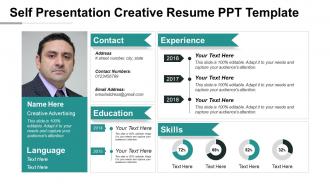
Presenting self-presentation creative resume PPT template PPT slide. The users can comfortably demonstrate their skills, experiences, and capabilities in a clear and vivid style by the use of this high-resolution PPT. Such PPT is of use to an individual during their career analysis at assessment centers. Sometimes the company representatives also use this slide to introduce themselves, their organization and their product and services. PPT is compatible with Google Slides, multiple software and format options. The content is thoroughly editable.

Presenting, meet our team representing in a circular format PPT design. This PPT slide contains visually engaging PPT presentation diagrams, which are loaded with incomparable benefits and can be utilized for displaying your team. Change the colors schemes used here, include your employee images and personalize. This design can be personalized by appending company trademark, logo, brand, symbols. Well-arranged patterns to avoid any confusion or uncertainty. These PPT slides can be instantly downloaded with just a click

This is the complete deck on company profiling with 65 slides. Pixels do not get blur in widescreen. Presentations are 100% risk-free. This deck is useful for company’s management, business corporates, business investors or any other corporate group. Slides are compatible with google slides. We give premium support to our clients. Our PPT templates are 100% editable in PowerPoint. The editable and multipurpose deck consists of company profiling, executive profile, company introduction
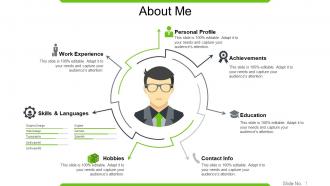
Presenting ours About Me PowerPoint Presentation Examples. This PPT layout is 100% adaptable allowing you to modify the font, color, font size, and shapes. You can save this PPT theme in formats like PDF, PNG, and JPG. This PowerPoint presentation is also accessible with Google Slides. It is available in both 4:3 and 16:9 aspect ratios.

This PPT is useful for employees, students, human resource management. This presentation is compatible with Google Slides. Prime support to customers. The presentation has 63 slides. Templates are easily editable in PowerPoint. Pixels do not get blur with widescreen. 100% risk-free downloads. The stages in this process are introduction about myself, introduce myself, best presentation on myself.
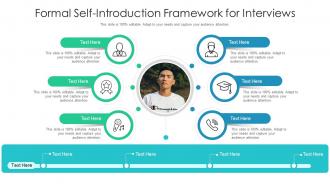
Deploy our Formal Self Introduction Framework For Interviews Infographic Template to present high quality presentations. It is designed in PowerPoint and is available for immediate download in standard and widescreen sizes. Not only this, but this layout is also 100 percent editable, giving you full control over its applications.

Presenting this set of slides with name - Product Launch Go To Market Strategy Powerpoint Presentation Slides. The stages in this process are Product Launch Go To Market Strategy, Entering A New Market, New Product Introduction.
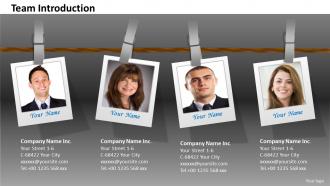
PPT sample design can be downloaded and saved into JPEG and PDF. Stress-free to comprehend information for the audience. Absolutely editable images, colors and text. Alternate of insertion of logo and icons as per the business need. Handy with different nodes and stages as required. Adjustable to wide screen view without any concern of pixilation. Presentation templates are totally compatible with Google slides
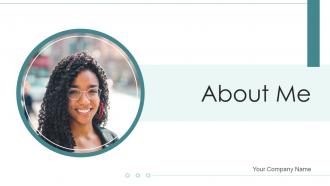
If you require a professional template with great design, then this About Me Business Skill Professional Expertise Technical Details is an ideal fit for you. Deploy it to enthrall your audience and increase your presentation threshold with the right graphics, images, and structure. Portray your ideas and vision using fourteen slides included in this complete deck. This template is suitable for expert discussion meetings presenting your views on the topic. With a variety of slides having the same thematic representation, this template can be regarded as a complete package. It employs some of the best design practices, so everything is well-structured. Not only this, it responds to all your needs and requirements by quickly adapting itself to the changes you make. This PPT slideshow is available for immediate download in PNG, JPG, and PDF formats, further enhancing its usability. Grab it by clicking the download button.

Presenting Self Introduction In Interview For Job PowerPoint Presentation Slides. This content ready PowerPoint presentation contains 39 visually appealing slides. PPT slides can be 100% editable. You can change the fonts, colors, and text as per your needs. Presentation templates can be downloaded in both widescreen and standard screen. The presentation is compatible with Google Slides. It can be easily converted into JPG or PDF format.
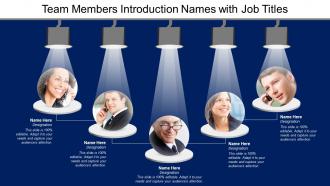
Presenting this set of slides with name - Team Members Introduction Names With Job Titles. This is a five stage process. The stages in this process are Team Member Introduction, Our Team, Team Profile.
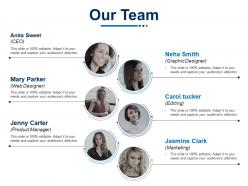
Presenting this set of slides with name Our Team Product Manager I49 Ppt Powerpoint Presentation File Design Templates. This is a six stage process. The stages in this process are Our Team, Communication, Management, Planning, Business. This is a completely editable PowerPoint presentation and is available for immediate download. Download now and impress your audience.
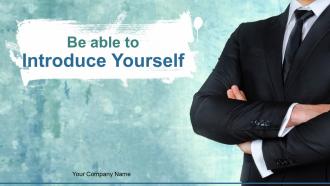
Presenting Be Able To Introduce Yourself Powerpoint Presentation Slides with editable PPT slides. All slides are professionally designed by our team of PowerPoint designers. The presentation content covers all areas of self-introduction and is extensively researched. This ready-to-use deck comprises visually stunning PowerPoint templates, icons, visual designs, data-driven charts and graphs and business diagrams. The deck consists of a total of 57 slides. You can customize this presentation as per your branding needs. You can change the font size, font type, colors as per your requirement. Download the presentation, enter your content in the placeholders and present with confidence!
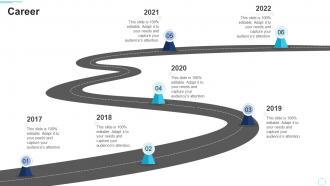
Introducing Career 10 Minutes Self Introduction Ppt Powerpoint Presentation Slides Example to increase your presentation threshold. Encompassed with six stages, this template is a great option to educate and entice your audience. Dispence information on Career, 2017 To 2022, using this template. Grab it now to reap its full benefits.
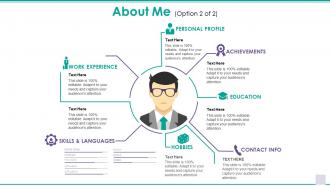
Presenting this set of slides with name - About Me Good Ppt Example. This is a one stage process. The stages in this process are Personal Profile, Achievements, Education, Contact Info, Skills And Languages, Work Experience, Hobbies.
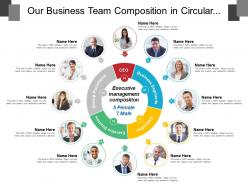
Presenting this set of slides with name - Our Business Team Composition In Circular Format. This is a two stage process. The stages in this process are Our Team, Our Group, Our Members.
Presenting this set of slides with name - Personal Professional Self Introduction With Icons. This is a one stage process. The stages in this process are Career Progression, Self Introduction, Work Experience.
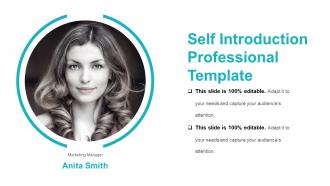
Highlighting self introduction professional template sample presentation PPT. PowerPoint layout is flexible with most software like JPG and PDF. Supreme picture quality design comes with high resolution picture as pixels never break even on wide screen. Presentation visual is easy to download and save. PowerPoint slide merges well with Google Slides. Preferences insert corporate details such as name, logo and tagline. Fully adaptable presentation graphic can be modified at any stage.
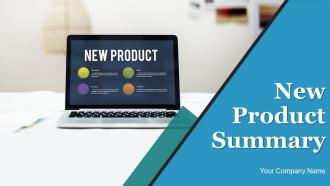
Presenting this set of slides with name - New Product Summary Powerpoint Presentation Slides. The multipurpose deck consist of New Product Overview, New Product Introduction, New Product Summary.
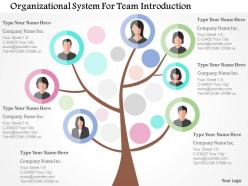
Simple and swift download without any hassles. Undiminished resolution of PPT infographics after editing any number of times. Absolutely editable color scheme and contrast of PPT images. Insert text to suit the context of your presentation. Change the size and orientation of PPT icons as per your requirement. Insert your own company logo, tagline, trademark etc.
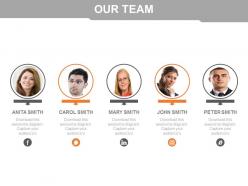
Fast and simple to download in quick easy steps. Totally editable text as per your need. Fully modifiable PPT icons- alter the size and orientation to your liking. Absolutely editable orientation and size of PPT infographics. No change in original high resolution of PPT images after editing. Insert this slide smoothly anywhere in your own presentation.
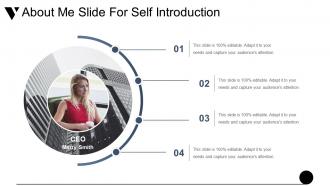
Presenting about me slide for a self-introduction example of a PPT slide. Well crafted, aesthetically designed and professionally proficient presentation. There is the use of impressive picture quality. High-resolution images do not pixelate when projected on a wide screen. PPT has thoroughly editable slides, so add or erase the content at your personal choice. Personalize the content with company name and logo. It is compatible with multiple online and offline software options. This PPT is harmonious with a large set of formats. Used by marketers, stakeholders, strategists, business analysts, and educators.
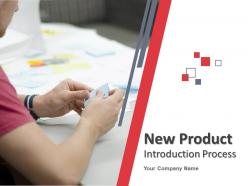
Presenting this set of slides with name - New Product Introduction Process Powerpoint Presentation Slides. The stages in this process are New Product Overview, New Product Introduction Process, New Product Summary.
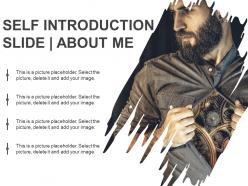
Edit visual to the way you want them to look. Download them with just a single click. Standard and widescreen support provided. Compatibility for Google Slides also. Suitable for use by businessmen, managers and firms. Premium Customer support service provided. This is a one stage process. The stages In this process are about me, about us, self introduction, company introduction, self presentation, visual resume.

This complete presentation has PPT slides on wide range of topics highlighting the core areas of your business needs. It has professionally designed templates with relevant visuals and subject driven content. This presentation deck has total of thirty four slides. Get access to the customizable templates. Our designers have created editable templates for your convenience. You can edit the colour, text and font size as per your need. You can add or delete the content if required. This easy to download PPT theme can be easily opened and saved in various formats like JPG, PDF, and PNG.
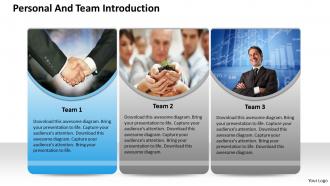
Ready to use get personal and team introduction PowerPoint template. 100% editable presentation slide. Text, font, colors and orientation can be easily changed as per your business requirements. Unaffected high resolution PPT slides even after customization. Well compatible with all the software’s and Google slides. Convertible into PDF or JPG formats. Useful for business presenters, politicians, corporate leaders, students, professors, etc. Personalize it with company name and logo of your own. Innovative PPT slide design for use. Adequate space provided with all presentation maps.
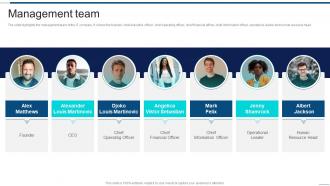
The slide highlights the management team of the IT company. It shows the founder, chief executive officer, chief operating officer, chief financial officer, chief information officer, operations leader and human resource head. Introducing Management Team Information Technology Company Profile Ppt Formats to increase your presentation threshold. Encompassed with seven stages, this template is a great option to educate and entice your audience. Dispense information on Operational Leader, Human Resource Head, Chief Operating Officer, using this template. Grab it now to reap its full benefits.
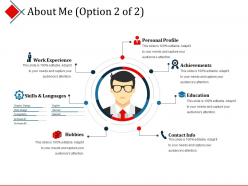
Presenting about me powerpoint slide presentation guidelines. This is a about me powerpoint slide presentation guidelines. This is a seven stage process. The stages in this process are personal profile, achievements, education, contact info, hobbies.
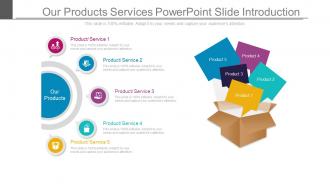
Presenting our products services powerpoint slide introduction. This is a our products services powerpoint slide introduction. This is five stage process. The stages in this process are product, icons, marketing, success, quotes, business.

Presenting this set of slides with name - Self Introduction In Interview For Experienced Candidates Powerpoint Presentation Slides. We bring to you to the point topic specific slides with apt research and understanding. Putting forth our PPT deck comprises of thirty nine slides. Our tailor made Self Introduction In Interview For Experienced Candidates Powerpoint Presentation Slides editable presentation deck assists planners to segment and expound the topic with brevity. The advantageous slides on Self Introduction In Interview For Experienced Candidates Powerpoint Presentation Slides is braced with multiple charts and graphs, overviews, analysis templates agenda slides etc. to help boost important aspects of your presentation. Highlight all sorts of related usable templates for important considerations. Our deck finds applicability amongst all kinds of professionals, managers, individuals, temporary permanent teams involved in any company organization from any field.
Make your presentation profoundly eye-catching leveraging our easily customizable Self introduction monotone icon in powerpoint pptx png and editable eps format. It is designed to draw the attention of your audience. Available in all editable formats, including PPTx, png, and eps, you can tweak it to deliver your message with ease.

Presenting Professional Self Introduction Powerpoint Presentation Slides. You can download this presentation easily and present it in standard screen(14:6) and widescreen (16:9) ratios. The font style, font color, and other components are completely editable. This fully compatible with Google slides which make it accessible at once. Transform this PPT into numerous documents or image formats like PDF or JPEG.

Business team introduction portfolio PowerPoint Slide. Editable images, colors and text as per our needs. Presentable and easy to comprehend info graphic format. The presentation template can be downloaded and saved in any desired format. Privilege of insertion of logo and trademarks for more personalization. Adaptable to wide screen view without the problem of pixilation. Can be used with Google slides. Easy to edit and customize as per your needs. Beneficial for industry professionals, managers, executives, researchers, sales people, etc.
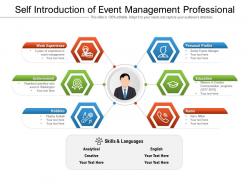
Presenting this set of slides with name Self Introduction Of Event Management Professional. This is a six stage process. The stages in this process are Personal Profile, Education, Work Experience, Achievement, Hobbies. This is a completely editable PowerPoint presentation and is available for immediate download. Download now and impress your audience.

Presenting this set of slides with name - New Product Description Powerpoint Presentation Slides. The stages in this process are New Product Description, New Product Introduction, New Product Summary.

This is a single slide titled Meet The Team For Marketing Department Infographic Template. It is crafted using high quality vector based visuals that are 100 percent editable and available for immediate download in standard and widescreen aspect ratios.

Introduce your topic and host expert discussion sessions with this New Employee Introduction Powerpoint Ppt Template Bundles. This template is designed using high-quality visuals, images, graphics, etc, that can be used to showcase your expertise. Different topics can be tackled using the thirteen slides included in this template. You can present each topic on a different slide to help your audience interpret the information more effectively. Apart from this, this PPT slideshow is available in two screen sizes, standard and widescreen making its delivery more impactful. This will not only help in presenting a birds-eye view of the topic but also keep your audience engaged. Since this PPT slideshow utilizes well-researched content, it induces strategic thinking and helps you convey your message in the best possible manner. The biggest feature of this design is that it comes with a host of editable features like color, font, background, etc. So, grab it now to deliver a unique presentation every time.

This PPT deck displays thirty four slides with in depth research. Our About Me Powerpoint Presentation Slides presentation deck is a helpful tool to plan, prepare, document and analyse the topic with a clear approach. We provide a ready to use deck with all sorts of relevant topics subtopics templates, charts and graphs, overviews, analysis templates. Outline all the important aspects without any hassle. It showcases of all kind of editable templates infographics for an inclusive and comprehensive About Me Powerpoint Presentation Slides presentation. This PowerPoint template is Google Slides compatible and is easily accessible. This easy to download PPT theme can be easily opened and saved in various formats like JPG, PDF, and PNG.
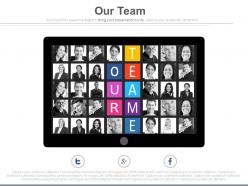
Maintenance of prevalent quality visuals all through the presentation. Compatible with wide screen yield. Can be enough used with any number of on the web and disengaged programming. The business slide representation is concordant with various game plan decisions. Give it a more redid look with your association logo and name. Edit the PPT shape, tints, shade, substance and that's only the tip of the iceberg. Used by advancing consultants, lenders, advertisers, dealers, and specialists.
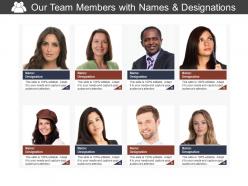
Presenting this set of slides with name - Our Team Members With Names And Designations. This is a eight stage process. The stages in this process are Our Team, Our Group, Our Members.
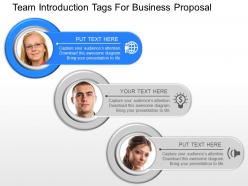
The PowerPoint presentation works well with Google slide. All the images are editable in PowerPoint manually. It can be easily converted to JPG and PDF format. PPT is designed in such manner that works without creating any unnecessary lag during the presentation. The quality of Images is assured and would not pixelate even shown on large screens. Easily amendable as editing is permissible with colour, text, and font.
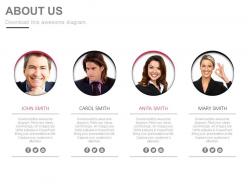
Presentation design totally adjustable with Google slides. Easy to download and can be converted into JPG and PDF format. Modifiable color, text and font as elements can be modifying. Choice of addition of logo and trademarks for business promotions. Sharing can be possible on both standard and widescreen. More designs available with different nodes and stages. Download takes less time and easy to save. Easy portray with ease to share the information effectively. Ready to use PowerPoint slide can be downloaded and shared at any time.
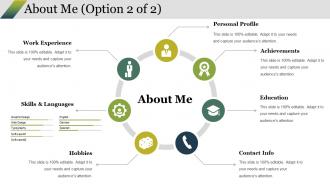
Presenting this set of slides with name - About Me Ppt Styles Example Introduction. This is a seven stage process. The stages in this process are Personal Profile, Achievements, Education, Contact Info, Hobbies, Work Experience.
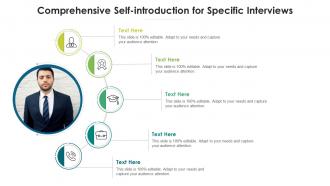
This is a single slide titled Comprehensive Self Introduction For Specific Interviews Infographic Template. It is crafted using high quality vector based visuals that are 100 percent editable and available for immediate download in standard and widescreen aspect ratios.
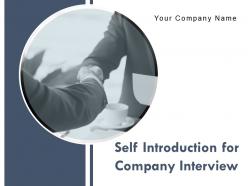
All slides are completely editable and professionally designed by our team of expert PowerPoint designers. The presentation content covers all areas of Self Introduction For Company Interview Powerpoint Presentation Slides and is extensively researched. This ready-to-use deck comprises visually stunning PowerPoint templates, icons, visual designs, data-driven charts and graphs and business diagrams. The deck consists of a total of thirty-six slides. You can customize this presentation as per your branding needs. You can change the font size, font type, colors as per your requirement. This PowerPoint template is Google Slides compatible and is easily accessible. This easy to download PPT theme can be easily opened and saved in various formats like JPG, PDF, and PNG.
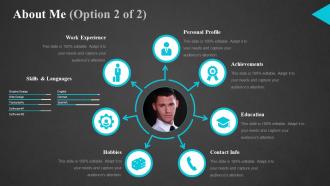
Presenting this set of slides with name - About Me Ppt Gallery. This is a seven stage process. The stages in this process are About Me, Achievements, Education, Hobbies, Contact Info.
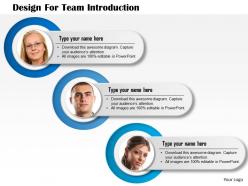
We are proud to present our 0714 business consulting design for team introduction powerpoint slide template. Use this diagram as team introduction slide in business presentation. Give your presentation a unique look and feel with this diagram. Transmit your thoughts via this slide and prod your team to action.
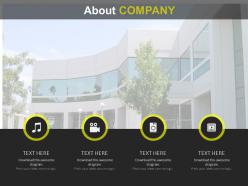
Creative and style based PPT icons which will help more audience engagement. Easy to download and simple formatting options. High resolution template, resolution is not affected by resizing. Helpful for business, corporate and marketing people. These PPT slides can be converted into different formats like JPEG and PDF. Vivid and clear slides that will attract attention of target people.

Presenting company introduction powerpoint ideas. This is a company introduction powerpoint ideas. This is a one stage process. The stages in this process are company introduction, about us, business, strategy, management, process.
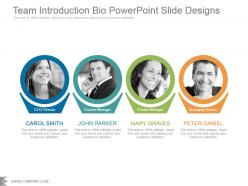
Presenting team introduction bio powerpoint slide designs. Presenting team introduction bio powerpoint slide designs. Presenting team introduction bio powerpoint slide designs. Presenting team introduction bio powerpoint slide designs. This is a team introduction bio powerpoint slide designs. This is a four stage process. The stages in this process are carol smith, john parker, mary graves, peter daniel.
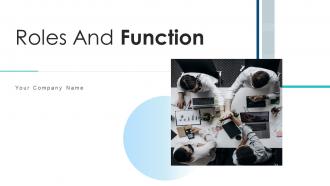
Engage buyer personas and boost brand awareness by pitching yourself using this prefabricated set. This Roles And Function Departments Depicting Leadership Organization Resource Management is a great tool to connect with your audience as it contains high-quality content and graphics. This helps in conveying your thoughts in a well-structured manner. It also helps you attain a competitive advantage because of its unique design and aesthetics. In addition to this, you can use this PPT design to portray information and educate your audience on various topics. With twelve slides, this is a great design to use for your upcoming presentations. Not only is it cost-effective but also easily pliable depending on your needs and requirements. As such color, font, or any other design component can be altered. It is also available for immediate download in different formats such as PNG, JPG, etc. So, without any further ado, download it now.

This PowerPoint slide can be used for business and management related presentations. The color of the elements shown in the template can be changed to your liking. You can include your company's logo after downloading this PPT slide and use it in the full-screen version for a better experience. Google compatible slides and completely adaptable. Edit the text and alter the icons according to your liking.

Presenting about me powerpoint slide presentation examples. This is a about me powerpoint slide presentation examples. This is a one stage process. The stages in this process are about me, business, plan, communication, marketing.

Deliver an informational PPT on various topics by using this New Product Introduction To Market Playbook Powerpoint Presentation Slides. This deck focuses and implements best industry practices, thus providing a birds-eye view of the topic. Encompassed with sixty six slides, designed using high-quality visuals and graphics, this deck is a complete package to use and download. All the slides offered in this deck are subjective to innumerable alterations, thus making you a pro at delivering and educating. You can modify the color of the graphics, background, or anything else as per your needs and requirements. It suits every business vertical because of its adaptable layout.
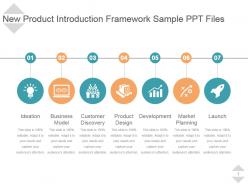
Presenting, new product introduction framework sample PPT files. This modern PPT template can be used for new product data related presentations. Downloading this PowerPoint slide will give you passage to its full version, which allows you to alter the colors, text, and positions of the elements presented. This PPT slide is also congenial with google slides and available in widescreen mode after downloading. Get ahead now.

Presenting introducing yourself powerpoint template. Presenting introducing yourself powerpoint template. Presenting introducing yourself powerpoint template. This is a introducing yourself powerpoint template. This is a one stage process. The stages in this process are title here, about me.

Deliver a credible and compelling presentation by deploying this IT Service Company Introduction Powerpoint Ppt Template Bundles. Intensify your message with the right graphics,images,icons,etc. presented in this complete deck. This PPT template is a great starting point to convey your messages and build a good collaboration. The twelve slides added to this PowerPoint slideshow helps you present a thorough explanation of the topic. You can use it to study and present various kinds of information in the form of stats,figures,data charts,and many more. This IT Service Company Introduction Powerpoint Ppt Template Bundles PPT slideshow is available for use in standard and widescreen aspects ratios. So,you can use it as per your convenience. Apart from this,it can be downloaded in PNG,JPG,and PDF formats,all completely editable and modifiable. The most profound feature of this PPT design is that it is fully compatible with Google Slides making it suitable for every industry and business domain.
Item 1 to 60 of 996 total items
- You're currently reading page 1

PowerPoint Tips Blog
Helping you with presenting, PowerPoint, and speaking
A good introduction/opener
February 10, 2011 by Ellen Finkelstein 263 Comments
You should start with an upbeat, positive mood. The first impression you make lasts. You want to quickly gain the attention, interest, and respect of your audience. Your first words should be lively, interesting, clear, and simple.
Start by expressing the fact that you’re glad to be there. A statement like, “I’m glad/excited/pleased/thrilled to be here” is almost obligatory. It invites the audience to be glad that they’re there, too. Your excitement is infectious and infuses the session with your energy.
Claudyne Wilder, in the July, 2007 issue of her newsletter, “Wilder’s Presentation Points,” said the following:
“A presenter who says, ‘I know you are busy people and have many things to do. Thank you for coming.’ only reminds everyone of all the things that they aren’t doing because they are sitting and listening. Distracting the audience before the presentation even begins is hardly a positive way to begin!”
Your introduction should answer the following
Who are you?
What is your topic, why is it important.
If you will be introduced, re-mention your name and re-affirm the most important fact about yourself that the audience will find meaningful, such as your experience with the topic. Otherwise, provide a slightly longer introduction, but just enough to let people know why they should listen to you.
Give a brief explanation of your topic, just a little longer than the title of your talk. Don’t give away the secret of your talk, but whet their appetite.
Finally, tell the audience why the topic is important to them. What will they have gained by the time the talk is finished? Don’t feel shy to promise that they’ll learn something useful; they really want to know that.
The entire opening should only take a minute or two. More than that, and it becomes boring because the audience will be impatient to hear the main content of your presentation.
Lori Giovannoni, in her e-book, So You Want to Be a Speaker , says, “Your intro should be well rehearsed, clear and filled with confidence. This is not the time to stammer and stutter and hope for the best. A poor intro will drop the energy in the room and you will spend the next half hour trying to recapture it.”
Here are some other ideas for openers:
- Ask your audience a question and ask them to raise hands in reply. For example, “How many of you regularly give presentations to small audiences of 1 to 10 people?”
- Begin with an interesting, relevant quote. Then use that quote to launch your talk. For example, “Author and columnist Earl Wilson said, ‘If you wouldn’t write it and sign it, don’t say it.’ This gives us a clue as to how you can gain believability from your audience.”
- Mention something another speaker said, or a current event, that is related to your presentation.
- Start with a short, relevant personal story or experience.
When you’ve written your introduction/opening, rewrite it and edit it until you like it. Then practice giving it out loud. Practice again. Time it. Record it and listen to it. Make adjustments and practice the new version. You should be able to speak it out without looking at your notes. When you’re done, you’ll have a great opener to your presentation!
Check out my other post on this topic, “How to start a presentation.”
Did you find this post helpful? Don’t miss out on new tips and get free video training here!
Please use the Share buttons below to share this with friends and colleagues, because they need to know how to start a presentation, too!
Learn easy principles and techniques that designers use. “ Slide Design for Non-Designers ” shows you, step-by-step, how to easily get the results you want. Plus bonus theme, template, sample slides, and 5 short video tutorials to make implementing the principles easy. Updated for PowerPoint 2016/365. Learn more at http://www.ellenfinkelstein.com/pptblog/slide-design-for-non-designers/
“101 Tips Every PowerPoint User Should Know” is for everyone who never took a course or read a book about PowerPoint! These tips will fill in the gaps, speed up your work, make presentations easier, and help you get better results. Now updated through PowerPoint 2016 and Office 365. Learn more at http://www.ellenfinkelstein.com/pptblog/101-tips/
Related posts:
- Create a looping introduction
- How to start a presentation
- Start your presentation BIG
- Use the 4 principles of meaningful communication
263 Leave a Reply
[…] This post was mentioned on Twitter by barbarashuck, Jen Juan. Jen Juan said: RT @EFinkelstein – a tip for PowerPoint: "A good introduction/opener" http://bit.ly/gWoTtC […]
I am 6th grade and I need to do the presentation about Bosnia and Herzegovina… And everyone knows my name because they all are my friends… I think it would be weird for me to introduce myself… What should I do to get people’s attention? Our teacher said that he is fairly disappointed about our introduction and conclusion… I would be thankful if you help me
Esther, You are right that you don’t need to introduce yourself in a classroom of your classmates. One way to get people’s attention would be to find some surprising fact about Bosnia and Herzegovina. Then you could start with, “Do you know that ….?” For example, you could ask your parents and parents of your friends where they are — show them a map. I bet that almost no one will be able to find them on the map. So you could start with, “Do you know that 90% of people don’t know where Bosnia and Herzegovina are?” Or you … Read more »
Hi,i am a 3rd year B.E student.I have to do the presentation about Global Wireless e-Voting.can you please help me, how to start my presentation and how to gain the attention of my audience?
hi i am a sophmore , and me and two other ppl r presenting a powerpoint on pandora (a godess) my teacher explained that “we should do an interesting introduction not just say,” my name is…this is a powerpoint on pandora” im not sure how my intro should be. help?
What is an interesting or surprising fact about Pandora? Start with that. For example, “Did you know that Pandora was the first mortal woman?”
“The first mortal women on earth, the releaser of disease,death and sorrow..pandora” sounds good? (:
and i do have stage fright, teachers have even deducted points off because i start out talking strong but i get real shacky and shy and my voice fades, ive been dealing with this for awhile, any recomdations? (thank you so much for your help)
Practice more. Videotape yourself and watch the videotape. Practice on your friends. Take a deep breath between sections–it’s good to pause! Don’t be too formal, be more conversational.
Yes, good start.
hye..i m a 9th standard student,and i want to give an introduction…on the topic lokpal bill.so would you please tell me..how to began my presentation…
Ishika, I don’t recognize that name, “lokpal bill.” Is it a person? If so, perhaps you can start with a surprising fact. Good luck!
Hi I am a 6th grader and I am doing a presentation on Justin Bieber and I dont know how to start it. Can you please help me?
Find some strange or funny fact about him and start, “Did you know that ….? That will get your audience interested. Maybe find a funny photo, too. Good luck!
Hello. I am an international researcher at a University and I am supposed to present my project in an international competition in from of a panel of internation judges. How do I introduce myself before I go to the main topic of my presentation? like who I am, where I am from, what do i do? Is it possible to provide me with a sentence? Thank you.
There won’t be any introduction for you at all? Not even your name? There won’t be a printed item with the list of presenters? If not, or even if there is, I would work it into the beginning of the presentation rather than a sentence before your topic. Is the competition based on the research — who did the best research? You could simply put your name and university on the title slide under the name of your presentation/research. You don’t need to say anything. Focus on the research. But, if you want to tell a story about how you … Read more »
Thank you. I will be starting with a story. I had an one on one coaching recently regarding this competition and I had my name and university on my slide just below my topic. After the presentation, one of the judge mentioned that I did not properly introduce myself, like my background, where I am from and so on. The reason was because I have a french accent, and the judge was wondering where I was from an so on.
Hi , I am doing a presentation about paper lantern and I don’t know how to start it. Can you please help me?
I’m not sure what you could say about paper lanterns, but perhaps start with a question to the audience, asking them what they use them for. Do something to engage the audience. Good luck!
i have to give a presentation on my internship.. how do i introduce & start my presentation to have a powerful impact on my examiner???
It’s hard to say, since I don’t know what your internship is about. Perhaps find a famous, philosophical quote and relate it to your internship to show you’ve thought deeply about its implications. Perhaps show a diagram placing the company where you worked in the context of the whole world, so they can see that you appreciate the larger impact of what they’re doing. Perhaps use a diagram showing the skills you learned and how they’ll apply to your professional life. Then go on and elaborate. Good luck!
Hi, I am a first year business student and me an my group need to do a presentation about the new venture we created. What would be a good introduction and how can we make our presentation interesting and engaging?
Rose, have you ever watched Shark Tank on TV? I’d recommend it, because the presentations are always engaging. They demo their product, wear costumes, etc. Aside from that, start by talking about the problem that your venture solves and relate it to the audience. “Have you ever experienced that….? Wasn’t it frustrating? How great would it be if….? Good luck!
Hi, i am doing a degree in early years and i have to do a 10 minute power point presentation on language and language theory in the early years. I am a little unsure how to start it because the group i am doing it in front of 5 people who already know my name and my job role?? also the presentation is all about how i promote language theory in my nursery setting so i am a little unsure about how to start it really.
thanks for reading
Tell a short story, ask a question, say a surprising fact, say something that’s different from usual. For example, you could start, “In this program, I’ve learned a lot of theory about language, but when I had an opportunity to use it in a nursery setting, I discovered some valuable approaches.”
hi, i am a student of pharmacy, and i have been given a topic of function of auxin(a phytohormone). can u please help me, that how would i start my topic and introduce myself in front of my classmates, as i’ll be the 3rd member in my group presentation of total 5 members. thanks,
Since I have NO idea what that is, it’s hard to give you an answer. Why is it important or interesting? Any stories about what happens when it doesn’t function properly?
Hi. I have to do a presentation over a lab that I did-oil spill cleanup. I’m not sure how to start. Could you give me some pointers, please? Thanks.
Hi , I am a student in the high school , I am going to give a presentation next week about positive thinking , I wonder how to start my presentation especially that I am with 3 friends in it !
Tell a horror story about an oil spill cleanup or just silently show some photos of birds covered with oil. Something striking.
I have to do a power point presentation in my class. How should I introduce my self – I am also doing business proposal
Unless your teacher expects you to introduce yourself, you don’t need to, since everyone in the class knows you, right? If it’s a huge class, that might be a different story. You could intertwine something about yourself into the business proposal — something about you that led you to decide that this proposal was the right thing.
Hello, Going through your previous replies, i must say you have done a wonderful job sharing your views and responding to each queries. I have one too 🙂 I am close to recruitment in a university as a lecturer, and before the official joining, the faculty head asked me to present a favorite topic of mine in front of the rest of the faculty members. I decided to present my Master’s thesis, but how would I introduce myself in front of my future co-workers? And what other details (apart from education details) would be relevant in the introduction slide?
Samir, Congratulations on your new job! I don’t think you want to put more than your education details on the first slide, but I think you want to say something verbally. You could introduce the topic of your Master’s thesis by saying something about how your background led you to this topic — so I’d add something personal because your future co-workers also want to get to know you as a person — but as a professional person. So don’t make it TOO personal.
i am a first year student and have been asked to make a presentation on myself, introducing myself to my new class mates and i have no clue where and how to start
Think of something unusual or especially interesting about you or your background or your goals and start with that. Then go on to the rest. Good luck!
i’m presenting a powerpoint presentation in front of my classmate together with my groupmates, I just like to have some tips on how to start my topic about recommendation report.?
Hi there, I am a grade 9 student and I have been assigned to do a presentation on the book ‘hatchet, by Gary Paulsen’. I am not too sure about what would be a good introduction to it, keeping everyone interested and involved. your help would be great, Please and Thank you
Since I know nothing about the book, it’s hard to say. Is there a surprising fact that you can find about the author if you do some research? Perhaps you can find a review of the book to find some background information. Did the book have an impact on you that your classmates wouldn’t expect? If the other students haven’t read it, is there a reason you think they should? How might it change their life? Good luck!
Im having a presentation about online shopping and I need help with my intruduction. Would you help me please? Thanks in advance!
Hai,this page is useful to us.I am doing my 3’rd year B.E.(EEE).i am going to present a paper on power electronics and drives.will u pls help me ? in wt way i have to introduce myself and impress my audience to my topic?
Hi Ellen. Judging by the number of comments and hits on this post, it’s a topic on many speakers’ minds! As you say, when speaking, your 1st impression lasts. I agree with many of your points, like the importance of whetting people’s appetites, and saying what they’ll gain. (To me though, saying “I’m glad to be here” seems a bit trite, and the audience doesn’t care (much) how you feel. They’re absorbed by their own needs and reason for attending, especially at the start.) As you say in your post’s last bullet, you can also use a short, relevant story. … Read more »
Hi, I recently join a company, and they told me to do a presentation on SDLC(Software Development Life Cycle. The problem is I don’t know how to introduce myself before the topic begin..
If everyone there knows you, you don’t have to introduce yourself. If they don’t, I suggest that you ask someone else to introduce you and say why you were chosen to do the presentation.
hello thank you for every thing you do. what i need to ask about is i’ll do a presentation of my self as a final test to get a job with the company(oil and gas company) what steps shoud i fallow to present my self as well.
Think about what the employer needs. Rather than talking about yourself, talk about how you can contribute to the success of the company. Do some research on the issues and future direction of the company and address that. Finally, be sure not to use slide after slide of bulleted text. Instead, make the presentation as visual as possible and practice giving it so you know what to say without reading the slides. Good luck!
I am doing a presentation on Emigration to Canada during the Famine. I am giving the talk in front of class mates and don’t want to introduce the presentation by saying ‘Hi my name is’. Can you give me any advice with regards to coming up with an interesting introduction. Much appreciated.
Nichola, I think your instincts are right. I’d just dive right in with a surprising or shocking fact or statistic about the emigration or the famine to bring home the emotional impact the situation had on the people involved. Are ask the audience a question. “What would you do if you had no food and your children were starving?” Good luck with the presentation!
Hi.. Good morning
I am doing a presentation on indian civilisation, can you please help with in how can i start my introduction and how to get the attention of the people listing ?
As I’ve mentioned in other comments, start with a surprising fact. Perhaps something like, “Did you know that Indian civilization ….?”
Hello, I have a presentation on American Conservative Union, and I don’t know how should I introduce the topic? What am I asking you is the introduction of this topic. Thank you
Got any suggestions?
We want to hear from you! Send us a message and help improve Slidesgo
Top searches
Trending searches

teacher appreciation
11 templates

cybersecurity
6 templates

spring season
34 templates

archaeology
45 templates

46 templates

23 templates
Professional Personal Introduction
Professional personal introduction presentation, free google slides theme and powerpoint template.
Download the "Professional Personal Introduction" presentation for PowerPoint or Google Slides. The world of business encompasses a lot of things! From reports to customer profiles, from brainstorming sessions to sales—there's always something to do or something to analyze. This customizable design, available for Google Slides and PowerPoint, is what you were looking for all this time. Use the slides to give your presentation a more professional approach and have everything under control.
Features of this template
- 100% editable and easy to modify
- Different slides to impress your audience
- Contains easy-to-edit graphics such as graphs, maps, tables, timelines and mockups
- Includes 500+ icons and Flaticon’s extension for customizing your slides
- Designed to be used in Google Slides and Microsoft PowerPoint
- Includes information about fonts, colors, and credits of the resources used
How can I use the template?
Am I free to use the templates?
How to attribute?
Attribution required If you are a free user, you must attribute Slidesgo by keeping the slide where the credits appear. How to attribute?
Related posts on our blog.

How to Add, Duplicate, Move, Delete or Hide Slides in Google Slides

How to Change Layouts in PowerPoint

How to Change the Slide Size in Google Slides
Related presentations.
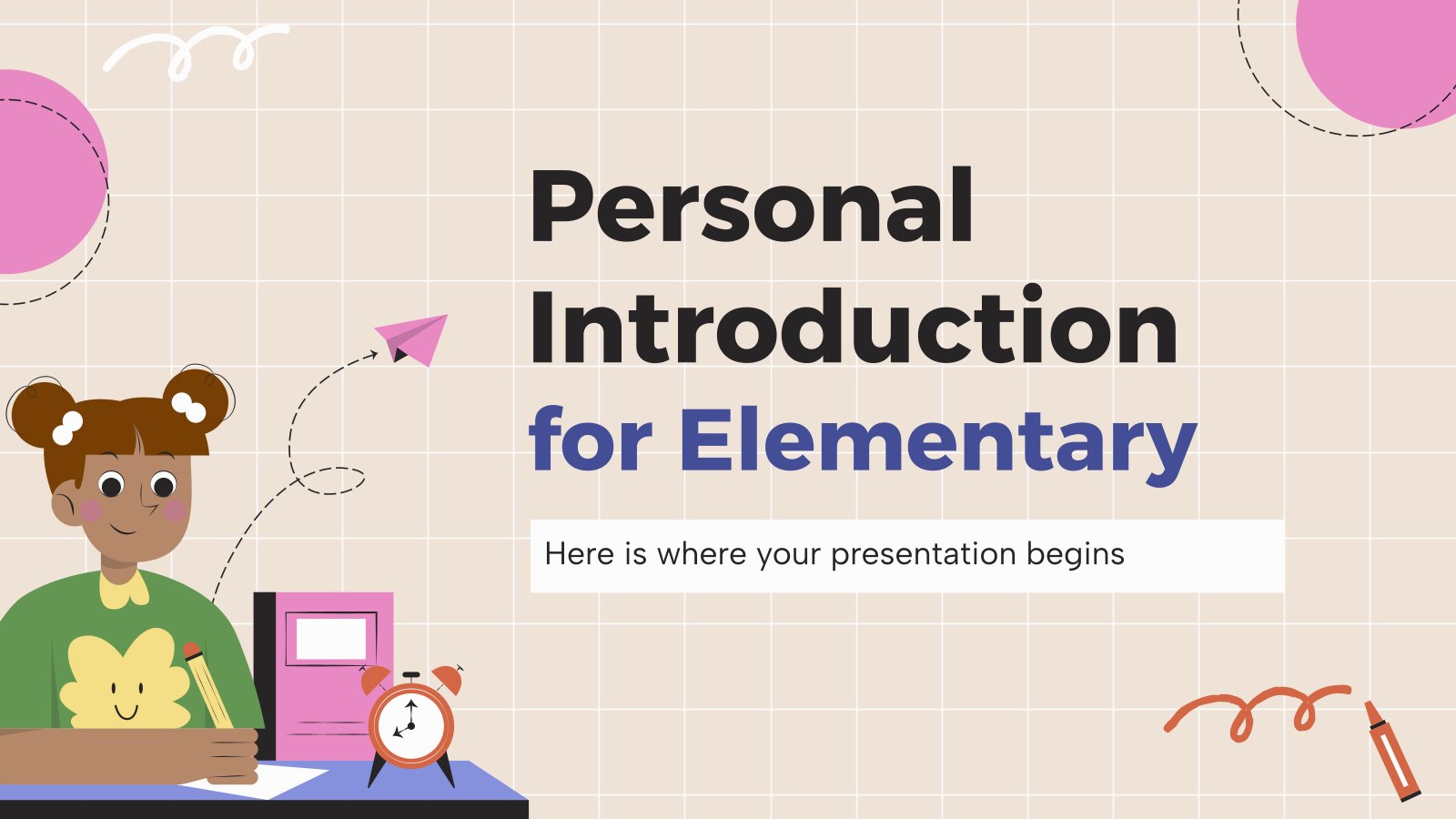
Premium template
Unlock this template and gain unlimited access

Register for free and start editing online
20 Great Examples of PowerPoint Presentation Design [+ Templates]
Published: January 17, 2024
When it comes to PowerPoint presentation design, there's no shortage of avenues you can take.

While all that choice — colors, formats, visuals, fonts — can feel liberating, it‘s important that you’re careful in your selection as not all design combinations add up to success.
![introduction slide presentation → Free Download: 10 PowerPoint Presentation Templates [Access Now]](https://no-cache.hubspot.com/cta/default/53/2d0b5298-2daa-4812-b2d4-fa65cd354a8e.png)
In this blog post, I’m sharing some of my favorite PowerPoint tips and templates to help you nail your next presentation.
Table of Contents
What makes a good PowerPoint presentation?
Powerpoint design ideas, best powerpoint presentation slides, good examples of powerpoint presentation design.
In my opinion, a great PowerPoint presentation gets the point across succinctly while using a design that doesn't detract from it.
Here are some of the elements I like to keep in mind when I’m building my own.
1. Minimal Animations and Transitions
Believe it or not, animations and transitions can take away from your PowerPoint presentation. Why? Well, they distract from the content you worked so hard on.
A good PowerPoint presentation keeps the focus on your argument by keeping animations and transitions to a minimum. I suggest using them tastefully and sparingly to emphasize a point or bring attention to a certain part of an image.
2. Cohesive Color Palette
I like to refresh my memory on color theory when creating a new PowerPoint presentation.
A cohesive color palette uses complementary and analogous colors to draw the audience’s attention and help emphasize certain aspects at the right time.

10 Free PowerPoint Templates
Download ten free PowerPoint templates for a better presentation.
- Creative templates.
- Data-driven templates.
- Professional templates.
You're all set!
Click this link to access this resource at any time.
Tell us a little about yourself below to gain access today:
It‘s impossible for me to tell you the specific design ideas you should go after in your next PowerPoint, because, well, I don’t know what the goal of your presentation is.
Luckily, new versions of PowerPoint actually suggest ideas for you based on the content you're presenting. This can help you keep up with the latest trends in presentation design .
PowerPoint is filled with interesting boilerplate designs you can start with. To find these suggestions, open PowerPoint and click the “Design” tab in your top navigation bar. Then, on the far right side, you'll see the following choices:


Atlas (Theme)
Covering a more creative subject for a younger or more energetic audience? I’d recommend using the cover slide design below. Its vibrant red color blocks and fun lines will appeal to your audience.
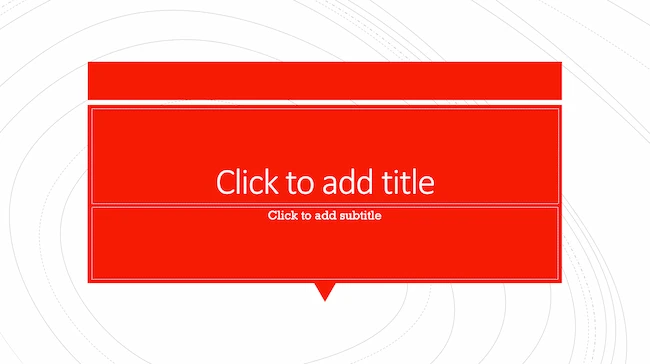
This simplistic presentation example employs several different colors and font weights, but instead of coming off as disconnected, the varied colors work with one another to create contrast and call out specific concepts.
What I like: The big, bold numbers help set the reader's expectations, as they clearly signify how far along the viewer is in the list of tips.
10. “Pixar's 22 Rules to Phenomenal Storytelling,” Gavin McMahon
This presentation by Gavin McMahon features color in all the right places. While each of the background images boasts a bright, spotlight-like design, all the characters are intentionally blacked out.
What I like: This helps keep the focus on the tips, while still incorporating visuals. Not to mention, it's still easy for me to identify each character without the details. (I found you on slide eight, Nemo.)
11. “Facebook Engagement and Activity Report,” We Are Social
Here's another great example of data visualization in the wild.
What I like: Rather than displaying numbers and statistics straight up, this presentation calls upon interesting, colorful graphs, and charts to present the information in a way that just makes sense.
12. “The GaryVee Content Model,” Gary Vaynerchuk
This wouldn‘t be a true Gary Vaynerchuk presentation if it wasn’t a little loud, am I right?
What I like: Aside from the fact that I love the eye-catching, bright yellow background, Vaynerchuk does a great job of incorporating screenshots on each slide to create a visual tutorial that coincides with the tips. He also does a great job including a visual table of contents that shows your progress as you go .
13. “20 Tweetable Quotes to Inspire Marketing & Design Creative Genius,” IMPACT Branding & Design
We‘ve all seen our fair share of quote-chronicling presentations but that isn’t to say they were all done well. Often the background images are poor quality, the text is too small, or there isn't enough contrast.
Well, this professional presentation from IMPACT Branding & Design suffers from none of said challenges.
What I like: The colorful filters over each background image create just enough contrast for the quotes to stand out.
14. “The Great State of Design,” Stacy Kvernmo
This presentation offers up a lot of information in a way that doesn't feel overwhelming.
What I like: The contrasting colors create visual interest and “pop,” and the comic images (slides 6 through 12) are used to make the information seem less buttoned-up and overwhelming.
15. “Clickbait: A Guide To Writing Un-Ignorable Headlines,” Ethos3
Not going to lie, it was the title that convinced me to click through to this presentation but the awesome design kept me there once I arrived.
What I like: This simple design adheres to a consistent color pattern and leverages bullet points and varied fonts to break up the text nicely.
16. “Digital Transformation in 50 Soundbites,” Julie Dodd
This design highlights a great alternative to the “text-over-image” display we've grown used to seeing.
What I like: By leveraging a split-screen approach to each presentation slide, Julie Dodd was able to serve up a clean, legible quote without sacrificing the power of a strong visual.
17. “Fix Your Really Bad PowerPoint,” Slide Comet
When you‘re creating a PowerPoint about how everyone’s PowerPoints stink, yours had better be terrific. The one above, based on the ebook by Seth Godin, keeps it simple without boring its audience.
What I like: Its clever combinations of fonts, together with consistent color across each slide, ensure you're neither overwhelmed nor unengaged.
18. “How Google Works,” Eric Schmidt
Simple, clever doodles tell the story of Google in a fun and creative way. This presentation reads almost like a storybook, making it easy to move from one slide to the next.
What I like: This uncluttered approach provides viewers with an easy-to-understand explanation of a complicated topic.
19. “What Really Differentiates the Best Content Marketers From The Rest,” Ross Simmonds
Let‘s be honest: These graphics are hard not to love. I especially appreciate the author’s cartoonified self-portrait that closes out the presentation. Well played, Ross Simmonds.
What I like: Rather than employing the same old stock photos, this unique design serves as a refreshing way to present information that's both valuable and fun.
20. “Be A Great Product Leader,” Adam Nash
This presentation by Adam Nash immediately draws attention by putting the company's logo first — a great move if your company is well known.
What I like: He uses popular images, such as ones of Megatron and Pinocchio, to drive his points home. In the same way, you can take advantage of popular images and media to keep your audience engaged.
PowerPoint Presentation Examples for the Best Slide Presentation
Mastering a PowerPoint presentation begins with the design itself.
Get inspired by my ideas above to create a presentation that engages your audience, builds upon your point, and helps you generate leads for your brand.
Editor's note: This post was originally published in March 2013 and has been updated for comprehensiveness. This article was written by a human, but our team uses AI in our editorial process. Check out our full disclosure to learn more about how we use AI.
![introduction slide presentation Blog - Beautiful PowerPoint Presentation Template [List-Based]](https://no-cache.hubspot.com/cta/default/53/013286c0-2cc2-45f8-a6db-c71dad0835b8.png)
Don't forget to share this post!
Related articles.
![introduction slide presentation How to Write an Ecommerce Business Plan [Examples & Template]](https://blog.hubspot.com/hubfs/ecommerce%20business%20plan.png)
How to Write an Ecommerce Business Plan [Examples & Template]
![introduction slide presentation How to Create an Infographic in Under an Hour — the 2024 Guide [+ Free Templates]](https://blog.hubspot.com/hubfs/Make-infographic-hero%20%28598%20%C3%97%20398%20px%29.jpg)
How to Create an Infographic in Under an Hour — the 2024 Guide [+ Free Templates]

Get Buyers to Do What You Want: The Power of Temptation Bundling in Sales

How to Create an Engaging 5-Minute Presentation
![introduction slide presentation How to Start a Presentation [+ Examples]](https://blog.hubspot.com/hubfs/how-to-start-presenting.webp)
How to Start a Presentation [+ Examples]
![introduction slide presentation 17 PowerPoint Presentation Tips to Make More Creative Slideshows [+ Templates]](https://blog.hubspot.com/hubfs/powerpoint-design-tricks_7.webp)
17 PowerPoint Presentation Tips to Make More Creative Slideshows [+ Templates]

120 Presentation Topic Ideas Help You Hook Your Audience
![introduction slide presentation How to Create the Best PowerPoint Presentations [Examples & Templates]](https://blog.hubspot.com/hubfs/Powerpoint%20presentation.jpg)
How to Create the Best PowerPoint Presentations [Examples & Templates]

The Presenter's Guide to Nailing Your Next PowerPoint
![introduction slide presentation How to Create a Stunning Presentation Cover Page [+ Examples]](https://blog.hubspot.com/hubfs/presentation-cover-page_3.webp)
How to Create a Stunning Presentation Cover Page [+ Examples]
Marketing software that helps you drive revenue, save time and resources, and measure and optimize your investments — all on one easy-to-use platform
Critical PowerPoint Shortcuts – Claim Your FREE Training Module and Get Your Time Back!

How to Make a PowerPoint Presentation (Step-by-Step)
- PowerPoint Tutorials
- Presentation Design
- January 22, 2024
In this beginner’s guide, you will learn step-by-step how to make a PowerPoint presentation from scratch.
While PowerPoint is designed to be intuitive and accessible, it can be overwhelming if you’ve never gotten any training on it before. As you progress through this guide, you’ll will learn how to move from blank slides to PowerPoint slides that look like these.

Table of Contents
Additionally, as you create your presentation, you’ll also learn tricks for working more efficiently in PowerPoint, including how to:
- Change the slide order
- Reset your layout
- Change the slide dimensions
- Use PowerPoint Designer
- Format text
- Format objects
- Play a presentation (slide show)
With this knowledge under your belt, you’ll be ready to start creating PowerPoint presentations. Moreover, you’ll have taken your skills from beginner to proficient in no time at all. I will also include links to more advanced PowerPoint topics.
Ready to start learning how to make a PowerPoint presentation?
Take your PPT skills to the next level
Start with a blank presentation.
Note: Before you open PowerPoint and start creating your presentation, make sure you’ve collected your thoughts. If you’re going to make your slides compelling, you need to spend some time brainstorming.
For help with this, see our article with tips for nailing your business presentation here .
The first thing you’ll need to do is to open PowerPoint. When you do, you are shown the Start Menu , with the Home tab open.
This is where you can choose either a blank theme (1) or a pre-built theme (2). You can also choose to open an existing presentation (3).
For now, go ahead and click on the Blank Presentation (1) thumbnail.

Doing so launches a brand new and blank presentation for you to work with. Before you start adding content to your presentation, let’s first familiarize ourselves with the PowerPoint interface.
The PowerPoint interface

Here is how the program is laid out:
- The Application Header
- The Ribbon (including the Ribbon tabs)
- The Quick Access Toolbar (either above or below the Ribbon)
- The Slides Pane (slide thumbnails)
The Slide Area
The notes pane.
- The Status Bar (including the View Buttons)
Each one of these areas has options for viewing certain parts of the PowerPoint environment and formatting your presentation.
Below are the important things to know about certain elements of the PowerPoint interface.
The PowerPoint Ribbon

The Ribbon is contextual. That means that it will adapt to what you’re doing in the program.
For example, the Font, Paragraph and Drawing options are greyed out until you select something that has text in it, as in the example below (A).

Furthermore, if you start manipulating certain objects, the Ribbon will display additional tabs, as seen above (B), with more commands and features to help you work with those objects. The following objects have their own additional tabs in the Ribbon which are hidden until you select them:
- Online Pictures
- Screenshots
- Screen Recording
The Slides Pane

This is where you can preview and rearrange all the slides in your presentation.
Right-clicking on a slide in the pane gives you additional options on the slide level that you won’t find on the Ribbon, such as Duplicate Slide , Delete Slide , and Hide Slide .

In addition, you can add sections to your presentation by right-clicking anywhere in this Pane and selecting Add Section . Sections are extremely helpful in large presentations, as they allow you to organize your slides into chunks that you can then rearrange, print or display differently from other slides.

The Slide Area (A) is where you will build out your slides. Anything within the bounds of this area will be visible when you present or print your presentation.
Anything outside of this area (B) will be hidden from view. This means that you can place things here, such as instructions for each slide, without worrying about them being shown to your audience.

The Notes Pane is the space beneath the Slide Area where you can type in the speaker notes for each slide. It’s designed as a fast way to add and edit your slides’ talking points.
To expand your knowledge and learn more about adding, printing, and exporting your PowerPoint speaker notes, read our guide here .
Your speaker notes are visible when you print your slides using the Notes Pages option and when you use the Presenter View . To expand your knowledge and learn the ins and outs of using the Presenter View , read our guide here .

You can resize the Notes Pane by clicking on its edge and dragging it up or down (A). You can also minimize or reopen it by clicking on the Notes button in the Status Bar (B).
Note: Not all text formatting displays in the Notes Pane, even though it will show up when printing your speaker notes. To learn more about printing PowerPoint with notes, read our guide here .
Now that you have a basic grasp of the PowerPoint interface at your disposal, it’s time to make your presentation.
Adding Content to Your PowerPoint Presentation
Notice that in the Slide Area , there are two rectangles with dotted outlines. These are called Placeholders and they’re set on the template in the Slide Master View .
To expand your knowledge and learn how to create a PowerPoint template of your own (which is no small task), read our guide here .

As the prompt text suggests, you can click into each placeholder and start typing text. These types of placeholder prompts are customizable too. That means that if you are using a company template, it might say something different, but the functionality is the same.

Note: For the purposes of this example, I will create a presentation based on the content in the Starbucks 2018 Global Social Impact Report, which is available to the public on their website.
If you type in more text than there is room for, PowerPoint will automatically reduce its font size. You can stop this behavior by clicking on the Autofit Options icon to the left of the placeholder and selecting Stop Fitting Text to this Placeholder .
Next, you can make formatting adjustments to your text by selecting the commands in the Font area and the Paragraph area of the Home tab of the Ribbon.

The Reset Command: If you make any changes to your title and decide you want to go back to how it was originally, you can use the Reset button up in the Home tab .

Insert More Slides into Your Presentation
Now that you have your title slide filled in, it’s time to add more slides. To do that, simply go up to the Home tab and click on New Slide . This inserts a new slide in your presentation right after the one you were on.

You can alternatively hit Ctrl+M on your keyboard to insert a new blank slide in PowerPoint. To learn more about this shortcut, see my guide on using Ctrl+M in PowerPoint .
Instead of clicking the New Slide command, you can also open the New Slide dropdown to see all the slide layouts in your PowerPoint template. Depending on who created your template, your layouts in this dropdown can be radically different.

If you insert a layout and later want to change it to a different layout, you can use the Layout dropdown instead of the New Slide dropdown.
After inserting a few different slide layouts, your presentation might look like the following picture. Don’t worry that it looks blank, next we will start adding content to your presentation.

If you want to follow along exactly with me, your five slides should be as follows:
- Title Slide
- Title and Content
- Section Header
- Two Content
- Picture with Caption
Adding Content to Your Slides
Now let’s go into each slide and start adding our content. You’ll notice some new types of placeholders.

On slide 2 we have a Content Placeholder , which allows you to add any kind of content. That includes:
- A SmartArt graphic,
- A 3D object,
- A picture from the web,
- Or an icon.
To insert text, simply type it in or hit Ctrl+C to Copy and Ctrl+V to Paste from elsewhere. To insert any of the other objects, click on the appropriate icon and follow the steps to insert it.
For my example, I’ll simply type in some text as you can see in the picture below.

Slides 3 and 4 only have text placeholders, so I’ll go ahead and add in my text into each one.

On slide 5 we have a Picture Placeholder . That means that the only elements that can go into it are:
- A picture from the web

To insert a picture into the picture placeholder, simply:
- Click on the Picture icon
- Find a picture on your computer and select it
- Click on Insert
Alternatively, if you already have a picture open somewhere else, you can select the placeholder and paste in (shortcut: Ctrl+V ) the picture. You can also drag the picture in from a file explorer window.

If you do not like the background of the picture you inserted onto your slide, you can remove the background here in PowerPoint. To see how to do this, read my guide here .
Placeholders aren’t the only way to add content to your slides. At any point, you can use the Insert tab to add elements to your slides.
You can use either the Title Only or the Blank slide layout to create slides for content that’s different. For example, a three-layout content slide, or a single picture divider slide, as shown below.

In the first example above, I’ve inserted 6 text boxes, 3 icons, and 3 circles to create this layout. In the second example, I’ve inserted a full-sized picture and then 2 shapes and 2 text boxes.
The Reset Command: Because these slides are built with shapes and text boxes (and not placeholders), hitting the Reset button up in the Home tab won’t do anything.
That is a good thing if you don’t want your layouts to adjust. However, it does mean that it falls on you to make sure everything is aligned and positioned correctly.
For more on how to add and manipulate the different objects in PowerPoint, check out our step-by-step articles here:
- Using graphics in PowerPoint
- Inserting icons onto slides
- Adding pictures to your PowerPoint
- How to embed a video in PowerPoint
- How to add music to your presentation
Using Designer to generate more layouts ideas
If you have Office 365, your version of PowerPoint comes with a new feature called Designer (or Design Ideas). This is a feature that generates slide layout ideas for you. The coolest thing about this feature is that it uses the content you already have.
To use Designer , simply navigate to the Design tab in your Ribbon, and click on Design Ideas .

NOTE: If the PowerPoint Designer is not working for you (it is grey out), see my troubleshooting guide for Designer .
Change the Overall Design (optional)
When you make a PowerPoint presentation, you’ll want to think about the overall design. Now that you have some content in your presentation, you can use the Design tab to change the look and feel of your slides.
For additional help thinking through the design of your presentation, read my guide here .
A. Picking your PowerPoint slide size
If you have PowerPoint 2013 or later, when you create a blank document in PowerPoint, you automatically start with a widescreen layout with a 16:9 ratio. These dimensions are suitable for most presentations as they match the screens of most computers and projectors.
However, you do have the option to change the dimensions.
For example, your presentation might not be presented, but instead converted into a PDF or printed and distributed. In that case, you can easily switch to the standard dimensions with a 4:3 ratio by selecting from the dropdown (A).
You can also choose a custom slide size or change the slide orientation from landscape to portrait in the Custom Slide Size dialog box (B).

To learn all about the different PowerPoint slide sizes, and some of the issues you will face when changing the slide size of a non-blank presentation, read my guide here .
B. Selecting a PowerPoint theme
The next thing you can do is change the theme of your presentation to a pre-built one. For a detailed explanation of what a PowerPoint theme is, and how to best use it, read my article here .
In the beginning of this tutorial, we started with a blank presentation, which uses the default Office theme as you can see in the picture below.

That gives you the most flexibility because it has a blank background and quite simple layouts that work for most presentations. However, it also means that it’s your responsibility to enhance the design.
If you’re comfortable with this, you can stay with the default theme or create your own custom theme ( read my guide here ). But if you would rather not have to think about design, then you can choose a pre-designed theme.
Microsoft provides 46 other pre-built themes, which include slide layouts, color variants and palettes, and fonts. Each one varies quite significantly, so make sure you look through them carefully.
To select a different theme, go to the Design tab in the Ribbon, and click on the dropdown arrow in the Themes section .

For this tutorial, let’s select the Frame theme and then choose the third Variant in the theme. Doing so changes the layout, colors, and fonts of your presentation.

Note: The theme dropdown area is also where you can import or save custom themes. To see my favorite places to find professional PowerPoint templates and themes (and recommendations for why I like them), read my guide here .
C. How to change a slide background in PowerPoint
The next thing to decide is how you want your background to look for the entire presentation. In the Variants area, you can see four background options.

For this example, we want our presentation to have a dark background, so let’s select Style 3. When you do so, you’ll notice that:
- The background color automatically changes across all slides
- The color of the text on most of the slides automatically changes to white so that it’s visible on the dark background
- The colors of the objects on slides #6 and #7 also adjust, in a way we may not want (we’ll likely have to make some manual adjustments to these slides)

Note: If you want to change the slide background for just that one slide, don’t left-click the style. Instead, right-click it and select Apply to Selected Slides .
After you change the background for your entire presentation, you can easily adjust the background for an individual slide.

Inside the Format Background pane, you can see you have the following options:
- Gradient fill
- Picture or texture fill
- Pattern fill
- Hide background
You can explore these options to find the PowerPoint background that best fits your presentation.
D. How to change your color palette in PowerPoint
Another thing you may want to adjust in your presentation, is the color scheme. In the picture below you can see the Theme Colors we are currently using for this presentation.

Each PowerPoint theme comes with its own color palette. By default, the Office theme includes the Office color palette. This affects the colors you are presented with when you format any element within your presentation (text, shapes, SmartArt, etc.).

The good news is that the colors here are easy to change. To switch color palettes, simply:
- Go to the Design tab in the Ribbon
- In the Variants area, click on the dropdown arrow and select Colors
- Select the color palette (or theme colors) you want
You can choose among the pre-built color palettes from Office, or you can customize them to create your own.
As you build your presentation, make sure you use the colors from your theme to format objects. That way, changing the color palette adjusts all the colors in your presentation automatically.
E. How to change your fonts in PowerPoint
Just as we changed the color palette, you can do the same for the fonts.

Each PowerPoint theme comes with its own font combination. By default, the Office theme includes the Office font pairing. This affects the fonts that are automatically assigned to all text in your presentation.

The good news is that the font pairings are easy to change. To switch your Theme Fonts, simply:
- Go to the Design tab in the Ribbon
- Click on the dropdown arrow in the Variants area
- Select Fonts
- Select the font pairing you want
You can choose among the pre-built fonts from Office, or you can customize them to create your own.
If you are working with PowerPoint presentations on both Mac and PC computers, make sure you choose a safe PowerPoint font. To see a list of the safest PowerPoint fonts, read our guide here .
If you receive a PowerPoint presentation and the wrong fonts were used, you can use the Replace Fonts dialog box to change the fonts across your entire presentation. For details, read our guide here .
Adding Animations & Transitions (optional)
The final step to make a PowerPoint presentation compelling, is to consider using animations and transitions. These are by no means necessary to a good presentation, but they may be helpful in your situation.
A. Adding PowerPoint animations
PowerPoint has an incredibly robust animations engine designed to power your creativity. That being said, it’s also easy to get started with basic animations.
Animations are movements that you can apply to individual objects on your slide.

To add a PowerPoint animation to an element of your slide, simply:
- Select the element
- Go to the Animations tab in the Ribbon
- Click on the dropdown arrow to view your options
- Select the animation you want
You can add animations to multiple objects at one time by selecting them all first and then applying the animation.
B. How to preview a PowerPoint animation

There are three ways to preview a PowerPoint animation:
- Click on the Preview button in the Animations tab
- Click on the little star next to the slide
- Play the slide in Slide Show Mode
To learn other ways to run your slide show, see our guide on presenting a PowerPoint slide show with shortcuts .
To adjust the settings of your animations, explore the options in the Effect Options , Advanced Animation and the Timing areas of the Animation tab .

Note: To see how to make objects appear and disappear in your slides by clicking a button, read our guide here .
C. How to manage your animations in PowerPoint

The best way to manage lots of animations on your slide is with the Animation Pane . To open it, simply:
- Navigate to the Animations tab
- Select the Animation Pane
Inside the Animation Pane, you’ll see all of the different animations that have been applied to objects on your slide, with their numbers marked as pictured above.
Note: To see examples of PowerPoint animations that can use in PowerPoint, see our list of PowerPoint animation tutorials here .
D. How to add transitions to your PowerPoint presentation
PowerPoint has an incredibly robust transition engine so that you can dictate how your slides change from one to the other. It is also extremely easy to add transitions to your slides.
In PowerPoint, transitions are the movements (or effects) you see as you move between two slides.

To add a transition to a PowerPoint slide, simply:
- Select the slide
- Go to the Transitions tab in the Ribbon
- In the Transitions to This Slide area, click on the dropdown arrow to view your options
- Select the transition you want
To adjust the settings of the transition, explore the options in the Timing area of the Transitions tab.
You can also add the same transition to multiple slides. To do that, select them in the Slides Pane and apply the transition.
E. How to preview a transition in PowerPoint

There are three ways to preview your PowerPoint transitions (just like your animations):
- Click on the Preview button in the Transitions tab
- Click on the little star beneath the slide number in the thumbnail view
Note: In 2016, PowerPoint added a cool new transition, called Morph. It operates a bit differently from other transitions. For a detailed tutorial on how to use the cool Morph transition, see our step-by-step article here .
Save Your PowerPoint Presentation
After you’ve built your presentation and made all the adjustments to your slides, you’ll want to save your presentation. YOu can do this several different ways.

To save a PowerPoint presentation using your Ribbon, simply:
- Navigate to the File tab
- Select Save As on the left
- Choose where you want to save your presentation
- Name your presentation and/or adjust your file type settings
- Click Save
You can alternatively use the Ctrl+S keyboard shortcut to save your presentation. I recommend using this shortcut frequently as you build your presentation to make sure you don’t lose any of your work.

This is the standard way to save a presentation. However, there may be a situation where you want to save your presentation as a different file type.
To learn how to save your presentation as a PDF, see our guide on converting PowerPoint to a PDF .
How to save your PowerPoint presentation as a template
Once you’ve created a presentation that you like, you may want to turn it into a template. The easiest – but not technically correct – way, is to simply create a copy of your current presentation and then change the content.
But be careful! A PowerPoint template is a special type of document and it has its own parameters and behaviors.
If you’re interested in learning about how to create your own PowerPoint template from scratch, see our guide on how to create a PowerPoint template .
Printing Your PowerPoint Presentation
After finishing your PowerPoint presentation, you may want to print it out on paper. Printing your slides is relatively easy.

To open the Print dialog box, you can either:
- Hit Ctrl+P on your keyboard
- Or go to the Ribbon and click on File and then Print

Inside the Print dialog box, you can choose from the various printing settings:
- Printer: Select a printer to use (or print to PDF or OneNote)
- Slides: Choose which slides you want to print
- Layout: Determine how many slides you want per page (this is where you can print the notes, outline, and handouts)
- Collated or uncollated (learn what collated printing means here )
- Color: Choose to print in color, grayscale or black & white
There are many more options for printing your PowerPoint presentations. Here are links to more in-depth articles:
- How to print multiple slides per page
- How to print your speaker notes in PowerPoint
- How to save PowerPoint as a picture presentation
So that’s how to create a PowerPoint presentation if you are brand new to it. We’ve also included a ton of links to helpful resources to boost your PowerPoint skills further.
When you are creating your presentation, it is critical to first focus on the content (what you are trying to say) before getting lost inserting and playing with elements. The clearer you are on what you want to present, the easier it will be to build it out in PowerPoint.
If you enjoyed this article, you can learn more about our PowerPoint training courses and other presentation resources by visiting us here .
🔒 Unlock the PowerPoint Shortcuts Trusted by Industry Leaders KKR, American Express, HSBC, and More!
Join over 114,880 professionals from diverse fields including consulting, investment banking, advertising, marketing, sales, and business development who have supercharged their PowerPoint game with our proven methods.
✅ Customize compelling presentations effortlessly.
✅ Master time-saving techniques for faster deck creation.
✅ Boost your career prospects with top-notch PowerPoint skills.
Get FREE access to the Critical PowerPoint Shortcuts module of our premium training course by entering your name and email below.
DISCLAIMER: PC Users Only!
We respect your privacy and will keep your info safe and confidential.
About The Author
Popular Tutorials
- How to Strikethrough Text (l̶i̶k̶e̶ ̶t̶h̶i̶s̶) in Word, Excel & PowerPoint
- How to Make Animated Fireworks in PowerPoint (Step-by-Step)
- Strikethrough Shortcut (l̶i̶k̶e̶ ̶t̶h̶i̶s̶) for Word, Excel & PowerPoint
- How to Create a Flash Card Memory Game in PowerPoint (Like Jeopardy)
- Keyboard Shortcuts Not Working: Solved
PowerPoint Tutorial Categories
- Strategies & Opinions
- Shortcuts & Hacks
- Pictures, Icons, Videos, Etc.
- New Features
- Miscellaneous
- Charts & Data Viz
We help busy professionals save hours and gain peace of mind, with corporate workshops, self-paced courses and tutorials for PowerPoint and Word.
Work With Us
- Corporate Training
- Presentation & Template Design
- Courses & Downloads
- PowerPoint Articles
- Word Articles
- Productivity Resources
Find a Tutorial
- Free Training
- For Businesses
We help busy office workers save hours and gain peace of mind, with tips, training and tutorials for Microsoft PowerPoint and Word.
Master Critical PowerPoint Shortcuts – Secure Your FREE Training Module and Save Valuable Time!
⌛ Master time-saving expert techniques.
🔥 Create powerful presentations.
🚀 Propel your career to new heights.
We value your privacy – we keep your info safe.
Discover PowerPoint Hacks Loved by Industry Giants - KKR, AmEx, HSBC!
Over 114,880 professionals in finance, marketing and sales have revolutionized their PPT skills with our proven methods.
Gain FREE access to a full module of our premium PowerPoint training program – Get started today!
We hate spam too and promise to keep your information safe.
You are currently viewing a placeholder content from Facebook . To access the actual content, click the button below. Please note that doing so will share data with third-party providers.
- PRO Courses Guides New Tech Help Pro Expert Videos About wikiHow Pro Upgrade Sign In
- EDIT Edit this Article
- EXPLORE Tech Help Pro About Us Random Article Quizzes Request a New Article Community Dashboard This Or That Game Popular Categories Arts and Entertainment Artwork Books Movies Computers and Electronics Computers Phone Skills Technology Hacks Health Men's Health Mental Health Women's Health Relationships Dating Love Relationship Issues Hobbies and Crafts Crafts Drawing Games Education & Communication Communication Skills Personal Development Studying Personal Care and Style Fashion Hair Care Personal Hygiene Youth Personal Care School Stuff Dating All Categories Arts and Entertainment Finance and Business Home and Garden Relationship Quizzes Cars & Other Vehicles Food and Entertaining Personal Care and Style Sports and Fitness Computers and Electronics Health Pets and Animals Travel Education & Communication Hobbies and Crafts Philosophy and Religion Work World Family Life Holidays and Traditions Relationships Youth
- Browse Articles
- Learn Something New
- Quizzes Hot
- This Or That Game New
- Train Your Brain
- Explore More
- Support wikiHow
- About wikiHow
- Log in / Sign up
- Education and Communications
- Presentations
How to Introduce Yourself in a Presentation
Last Updated: October 4, 2023 Fact Checked
This article was co-authored by Patrick Muñoz . Patrick is an internationally recognized Voice & Speech Coach, focusing on public speaking, vocal power, accent and dialects, accent reduction, voiceover, acting and speech therapy. He has worked with clients such as Penelope Cruz, Eva Longoria, and Roselyn Sanchez. He was voted LA's Favorite Voice and Dialect Coach by BACKSTAGE, is the voice and speech coach for Disney and Turner Classic Movies, and is a member of Voice and Speech Trainers Association. There are 11 references cited in this article, which can be found at the bottom of the page. This article has been fact-checked, ensuring the accuracy of any cited facts and confirming the authority of its sources. This article has been viewed 124,596 times.
Introducing yourself in a presentation is more than just saying your name. It’s an opportunity for you to share relevant details about yourself and connect with your audience. It also sets the tone for the rest of the talk. How you introduce yourself will influence how your audience receives the message you want to get across. Make your next introduction flawless by presenting the most engaging information about yourself. Be sure to prepare the introduction in advance and start with an attention-grabbing technique to connect to the audience.
Including Relevant Information in Your Introduction

- If you have an unusual or difficult to pronounce name, you may want to add a small remark to help your audience remember it. For example, you can say “My name is Jacob Misen, like ‘risen’ but with an M.”
- Try to make eye contact with parts of audience during your presentation as well. [1] X Research source

- If you are VP of Marketing at a large company, it can actually be much more effective to say something like “I have more than a decade of experience using Facebook marketing ads to target clients in the dance industry” rather than simply stating your job title.

- You can also specifically refer your audience to the handout or powerpoint for more information. For example, if you want to let them know that you have articles in many international newspapers but you don’t want to list them all out, simply say “I’ve written for a number of internationally recognized news organizations. You can find the full list on the first page of my handout.”

- For example, you could say “when I designed a website for Richard Branson last year …” to inform your audience that you have an impressive resume, without having to list it all for them in your introduction.

- Try concluding your introduction by mentioning a client or project you were working on that directly relates to the topic of your presentation. For example: “I’ve had the pleasure of working with NXP Semiconductors for the past three years. Just last week we encountered a problem with our logistical database...” and then lead into your presentation about a new software that will solve everyone’s logistical hiccups.
Grabbing Your Audience’s Attention Before Your Introduction

- If you don’t have music that can tie to your presentation, you can use a song with the theme of beginning. For example, if you are presenting at a sales meeting, play some soft jazz as participants enter. Then, when it’s time for you to start, play the Black Eyed Peas chorus of “Let’s Get it Started” to get your audience’s attention. You can then open with an energetic “Good morning!” or “Good Afternoon” as the music ends.
- Remember to choose music that’s appropriate to the event. An academic conference may not be the best place for pop music, for example (unless you are presenting research on pop music, of course).

- For example, if you are presenting on the design of a new user-friendly coffee machine, you may start your presentation by referencing Elon Musk: “Any product that needs a manual to work is broken,” and then go on to say “My name is Laurie Higgens, and my coffee machine doesn’t come with a manual.” Speak briefly about your relevant experience and qualifications, and then dive into presenting your design.
- Avoid cliche or overused motivational quotes the audience has probably already heard many times.
- Be sure to correctly cite your quote.

- For example, you might start with “According to Time magazine, Americans filled 4.3 billion prescriptions and doled out $374 billion on medicine in 2014.” Then, introduce yourself and your qualifications in medical research and transition into a presentation about how to prevent doctors from over prescribing medication to their patients.
- Remember to cite the source of your statistics. You will look more professional and reliable, and the audience will be able to follow up on the information if they wish.

- If you are giving a presentation about a new airport security-friendly travel bag, try starting your presentation with “How many of you have ever stood in line at airport security and nearly missed your flight?”
- You can also invite your audience to close their eyes and imagine something as you lead up to your question.
- Don’t be discouraged if your audience doesn’t raise their hands when you ask a question. Sometimes these questions seem more rhetorical to an audience, or maybe they are just shy. You can often see signs that they are still engaging with the question if people are nodding or smiling after you ask it.

- Try telling stories, showing pictures on a powerpoint, or using quotations.
- Being funny not only puts your audience at ease, but it also helps them remember you after the presentation. [10] X Research source

- For example, if you are making a presentation about a pizza delivery app, ask your audience members to tell their name, their favorite pizza topping, and a situation where they’ve had a particularly amazing or awful experience with food delivery.
Preparing Before Your Presentation

- When it’s time to present, it’s probably best to just write down a few notes or key words to remind you of what you want to say so you don’t just read off your note cards.
- Think about your overall intention as a speaker. Are you trying to educate, enlighten, or entertain the audience? Figure out the effect you want to have on the listener so your presentation is impactful.

- If you don’t have a friend to watch your presentation, record yourself on video and play it back later to refine your presentation skills. It can be uncomfortable to watch yourself on video, but it will help you nail your introduction. You can even record your whole presentation. Keep recording and re-recording until you are happy with it. Then you know the audience will be happy too.

- The best resource to learn about the local culture is the locals themselves. If you have a contact where you will be speaking, ask them about customs, dress code, and how humor is usually received. If you don’t know anyone personally, try searching in industry-specific online forums. Find YouTube videos of presentations given in the area that are relevant to your industry.
What Is The Best Way To Start a Presentation?
Expert Q&A

- Don’t spend too much time introducing yourself. Your introduction should be short and to the point so you can get on to your main presentation material. Depending on the length of your presentation, your introduction should be between 20 seconds and 2 minutes long. Thanks Helpful 1 Not Helpful 0

You Might Also Like

- ↑ https://www.canr.msu.edu/news/eye_contact_tips_to_make_your_presentations_stronger
- ↑ https://www.indeed.com/career-advice/career-development/introduce-yourself-professionally
- ↑ https://www.washington.edu/doit/presentation-tips-0
- ↑ https://www.gvsu.edu/ours/oral-presentation-tips-30.htm
- ↑ https://www.forbes.com/sites/forbescoachescouncil/2018/09/27/15-hacks-for-making-your-presentation-more-creative-and-engaging/
- ↑ https://www.hamilton.edu/academics/centers/oralcommunication/guides/how-to-engage-your-audience-and-keep-them-with-you
- ↑ https://www.linkedin.com/pulse/make-em-laugh-ten-tips-using-humor-presentations-judy-romano-mba?trk=portfolio_article-card_title
- ↑ https://www.ncsl.org/legislators-staff/legislative-staff/legislative-staff-coordinating-committee/tips-for-making-effective-powerpoint-presentations.aspx
- ↑ https://crln.acrl.org/index.php/crlnews/article/view/19102/22119
- ↑ https://www.forbes.com/sites/tjwalker/2011/06/07/should-i-rehearse-and-for-how-long-presentation-training/
About This Article

To introduce yourself at the start of your presentation, all you need to do is state your name and tell the audience any relevant experience or skills you have. For example, say something like, “My name is Jacob Misen, and I have over a decade of experience using Facebook marketing ads in the dance industry.” If you have a broad range of relevant experience, you can bullet point a few examples on your opening slide instead of reading them out. Once you’ve introduced yourself, smoothly transition into your presentation. For instance, you can mention a client or project you’ve recently worked on that relates to the topic of your presentation. For more tips, including how to practice your presentation, read on! Did this summary help you? Yes No
- Send fan mail to authors
Reader Success Stories
Jun 16, 2023
Did this article help you?

Featured Articles

Trending Articles

Watch Articles

- Terms of Use
- Privacy Policy
- Do Not Sell or Share My Info
- Not Selling Info
Get all the best how-tos!
Sign up for wikiHow's weekly email newsletter

Basic tasks for creating a PowerPoint presentation
PowerPoint presentations work like slide shows. To convey a message or a story, you break it down into slides. Think of each slide as a blank canvas for the pictures and words that help you tell your story.
Choose a theme
When you open PowerPoint, you’ll see some built-in themes and templates . A theme is a slide design that contains matching colors, fonts, and special effects like shadows, reflections, and more.
On the File tab of the Ribbon, select New , and then choose a theme.
PowerPoint shows you a preview of the theme, with four color variations to choose from on the right side.
Click Create , or pick a color variation and then click Create .

Read more: Use or create themes in PowerPoint
Insert a new slide
On the Home tab, click the bottom half of New Slide , and pick a slide layout.

Read more: Add, rearrange, and delete slides .
Save your presentation
On the File tab, choose Save .
Pick or browse to a folder.
In the File name box, type a name for your presentation, and then choose Save .
Note: If you frequently save files to a certain folder, you can ‘pin’ the path so that it is always available (as shown below).

Tip: Save your work as you go. Press Ctrl+S often or save the file to OneDrive and let AutoSave take care of it for you.
Read more: Save your presentation file
Select a text placeholder, and begin typing.

Format your text
Select the text.
Under Drawing Tools , choose Format .

Do one of the following:
To change the color of your text, choose Text Fill , and then choose a color.
To change the outline color of your text, choose Text Outline , and then choose a color.
To apply a shadow, reflection, glow, bevel, 3-D rotation, a transform, choose Text Effects , and then choose the effect you want.
Change the fonts
Change the color of text on a slide
Add bullets or numbers to text
Format text as superscript or subscript
Add pictures
On the Insert tab, select Pictures , then do one of the following:
To insert a picture that is saved on your local drive or an internal server, choose This Device , browse for the picture, and then choose Insert .
(For Microsoft 365 subscribers) To insert a picture from our library, choose Stock Images , browse for a picture, select it and choose Insert .
To insert a picture from the web, choose Online Pictures , and use the search box to find a picture. Choose a picture, and then click Insert .

You can add shapes to illustrate your slide.
On the Insert tab, select Shapes , and then select a shape from the menu that appears.
In the slide area, click and drag to draw the shape.
Select the Format or Shape Format tab on the ribbon. Open the Shape Styles gallery to quickly add a color and style (including shading) to the selected shape.

Add speaker notes
Slides are best when you don’t cram in too much information. You can put helpful facts and notes in the speaker notes, and refer to them as you present.

Click inside the Notes pane below the slide, and begin typing your notes.

Add speaker notes to your slides
Print slides with or without speaker notes
Give your presentation
On the Slide Show tab, do one of the following:
To start the presentation at the first slide, in the Start Slide Show group, click From Beginning .

If you’re not at the first slide and want to start from where you are, click From Current Slide .
If you need to present to people who are not where you are, click Present Online to set up a presentation on the web, and then choose one of the following options:
Broadcast your PowerPoint presentation online to a remote audience
View your speaker notes as you deliver your slide show.
Get out of Slide Show view
To get out of Slide Show view at any time, on the keyboard, press Esc .
You can quickly apply a theme when you're starting a new presentation:
On the File tab, click New .
Select a theme.

Read more: Apply a design theme to your presentation
In the slide thumbnail pane on the left, select the slide that you want your new slide to follow.
On the Home tab, select the lower half of New Slide .
From the menu, select the layout that you want for your new slide.
Your new slide is inserted, and you can click inside a placeholder to begin adding content.
Learn more about slide layouts
Read more: Add, rearrange, and delete slides
PowerPoint for the web automatically saves your work to your OneDrive, in the cloud.
To change the name of the automatically saved file:
In the title bar, click the file name.
In the File Name box, enter the name you want to apply to the file.
If you want to change the cloud storage location, at the right end of the Location box, click the arrow symbol, then navigate to the folder you want, then select Move here .
On the Home tab, use the Font options:

Select from other formatting options such as Bold , Italic , Underline , Strikethrough , Subscript , and Superscript .
On the Insert tab, select Pictures .
From the menu, select where you want to insert the picture from:

Browse to the image you want, select it, then select Insert .
After the image is inserted on the slide, you can select it and drag to reposition it, and you can select and drag a corner handle to resize the image.
On the slide canvas, click and drag to draw the shape.
Select the Shape tab on the ribbon. Open the Shape Styles gallery to quickly add a color and style (including shading) to the selected shape.

A horizontal Notes pane appears at the bottom of the window, below the slide.
Click in the pane, then enter text.

On the Slide Show tab, select Play From Beginning .

To navigate through the slides, simply click the mouse or press the spacebar.
Tip: You can also use the forward and back arrow keys on your keyboard to navigate through the slide show.
Read more: Present your slide show
Stop a slide show
To get out of Slide Show view at any time, on the keyboard, press Esc.
The full-screen slide show will close, and you will be returned to the editing view of the file.
Tips for creating an effective presentation
Consider the following tips to keep your audience interested.
Minimize the number of slides
To maintain a clear message and to keep your audience attentive and interested, keep the number of slides in your presentation to a minimum.
Choose an audience-friendly font size
The audience must be able to read your slides from a distance. Generally speaking, a font size smaller than 30 might be too difficult for the audience to see.
Keep your slide text simple
You want your audience to listen to you present your information, instead of reading the screen. Use bullets or short sentences, and try to keep each item to one line.
Some projectors crop slides at the edges, so that long sentences might be cropped.
Use visuals to help express your message
Pictures, charts, graphs, and SmartArt graphics provide visual cues for your audience to remember. Add meaningful art to complement the text and messaging on your slides.
As with text, however, avoid including too many visual aids on your slide.
Make labels for charts and graphs understandable
Use only enough text to make label elements in a chart or graph comprehensible.
Apply subtle, consistent slide backgrounds
Choose an appealing, consistent template or theme that is not too eye-catching. You don't want the background or design to detract from your message.
However, you also want to provide a contrast between the background color and text color. The built-in themes in PowerPoint set the contrast between a light background with dark colored text or dark background with light colored text.
For more information about how to use themes, see Apply a theme to add color and style to your presentation .
Check the spelling and grammar
To earn and maintain the respect of your audience, always check the spelling and grammar in your presentation .
Top of Page

Need more help?
Want more options.
Explore subscription benefits, browse training courses, learn how to secure your device, and more.

Microsoft 365 subscription benefits

Microsoft 365 training

Microsoft security

Accessibility center
Communities help you ask and answer questions, give feedback, and hear from experts with rich knowledge.

Ask the Microsoft Community

Microsoft Tech Community

Windows Insiders
Microsoft 365 Insiders
Was this information helpful?
Thank you for your feedback.

- SUGGESTED TOPICS
- The Magazine
- Newsletters
- Managing Yourself
- Managing Teams
- Work-life Balance
- The Big Idea
- Data & Visuals
- Reading Lists
- Case Selections
- HBR Learning
- Topic Feeds
- Account Settings
- Email Preferences
How to Make a “Good” Presentation “Great”
- Guy Kawasaki

Remember: Less is more.
A strong presentation is so much more than information pasted onto a series of slides with fancy backgrounds. Whether you’re pitching an idea, reporting market research, or sharing something else, a great presentation can give you a competitive advantage, and be a powerful tool when aiming to persuade, educate, or inspire others. Here are some unique elements that make a presentation stand out.
- Fonts: Sans Serif fonts such as Helvetica or Arial are preferred for their clean lines, which make them easy to digest at various sizes and distances. Limit the number of font styles to two: one for headings and another for body text, to avoid visual confusion or distractions.
- Colors: Colors can evoke emotions and highlight critical points, but their overuse can lead to a cluttered and confusing presentation. A limited palette of two to three main colors, complemented by a simple background, can help you draw attention to key elements without overwhelming the audience.
- Pictures: Pictures can communicate complex ideas quickly and memorably but choosing the right images is key. Images or pictures should be big (perhaps 20-25% of the page), bold, and have a clear purpose that complements the slide’s text.
- Layout: Don’t overcrowd your slides with too much information. When in doubt, adhere to the principle of simplicity, and aim for a clean and uncluttered layout with plenty of white space around text and images. Think phrases and bullets, not sentences.
As an intern or early career professional, chances are that you’ll be tasked with making or giving a presentation in the near future. Whether you’re pitching an idea, reporting market research, or sharing something else, a great presentation can give you a competitive advantage, and be a powerful tool when aiming to persuade, educate, or inspire others.
- Guy Kawasaki is the chief evangelist at Canva and was the former chief evangelist at Apple. Guy is the author of 16 books including Think Remarkable : 9 Paths to Transform Your Life and Make a Difference.
Partner Center

Improve your practice.
Enhance your soft skills with a range of award-winning courses.
How to Structure your Presentation, with Examples
August 3, 2018 - Dom Barnard
For many people the thought of delivering a presentation is a daunting task and brings about a great deal of nerves . However, if you take some time to understand how effective presentations are structured and then apply this structure to your own presentation, you’ll appear much more confident and relaxed.
Here is our complete guide for structuring your presentation, with examples at the end of the article to demonstrate these points.
Why is structuring a presentation so important?
If you’ve ever sat through a great presentation, you’ll have left feeling either inspired or informed on a given topic. This isn’t because the speaker was the most knowledgeable or motivating person in the world. Instead, it’s because they know how to structure presentations – they have crafted their message in a logical and simple way that has allowed the audience can keep up with them and take away key messages.
Research has supported this, with studies showing that audiences retain structured information 40% more accurately than unstructured information.
In fact, not only is structuring a presentation important for the benefit of the audience’s understanding, it’s also important for you as the speaker. A good structure helps you remain calm, stay on topic, and avoid any awkward silences.
What will affect your presentation structure?
Generally speaking, there is a natural flow that any decent presentation will follow which we will go into shortly. However, you should be aware that all presentation structures will be different in their own unique way and this will be due to a number of factors, including:
- Whether you need to deliver any demonstrations
- How knowledgeable the audience already is on the given subject
- How much interaction you want from the audience
- Any time constraints there are for your talk
- What setting you are in
- Your ability to use any kinds of visual assistance
Before choosing the presentation’s structure answer these questions first:
- What is your presentation’s aim?
- Who are the audience?
- What are the main points your audience should remember afterwards?
When reading the points below, think critically about what things may cause your presentation structure to be slightly different. You can add in certain elements and add more focus to certain moments if that works better for your speech.

What is the typical presentation structure?
This is the usual flow of a presentation, which covers all the vital sections and is a good starting point for yours. It allows your audience to easily follow along and sets out a solid structure you can add your content to.
1. Greet the audience and introduce yourself
Before you start delivering your talk, introduce yourself to the audience and clarify who you are and your relevant expertise. This does not need to be long or incredibly detailed, but will help build an immediate relationship between you and the audience. It gives you the chance to briefly clarify your expertise and why you are worth listening to. This will help establish your ethos so the audience will trust you more and think you’re credible.
Read our tips on How to Start a Presentation Effectively
2. Introduction
In the introduction you need to explain the subject and purpose of your presentation whilst gaining the audience’s interest and confidence. It’s sometimes helpful to think of your introduction as funnel-shaped to help filter down your topic:
- Introduce your general topic
- Explain your topic area
- State the issues/challenges in this area you will be exploring
- State your presentation’s purpose – this is the basis of your presentation so ensure that you provide a statement explaining how the topic will be treated, for example, “I will argue that…” or maybe you will “compare”, “analyse”, “evaluate”, “describe” etc.
- Provide a statement of what you’re hoping the outcome of the presentation will be, for example, “I’m hoping this will be provide you with…”
- Show a preview of the organisation of your presentation
In this section also explain:
- The length of the talk.
- Signal whether you want audience interaction – some presenters prefer the audience to ask questions throughout whereas others allocate a specific section for this.
- If it applies, inform the audience whether to take notes or whether you will be providing handouts.
The way you structure your introduction can depend on the amount of time you have been given to present: a sales pitch may consist of a quick presentation so you may begin with your conclusion and then provide the evidence. Conversely, a speaker presenting their idea for change in the world would be better suited to start with the evidence and then conclude what this means for the audience.
Keep in mind that the main aim of the introduction is to grab the audience’s attention and connect with them.
3. The main body of your talk
The main body of your talk needs to meet the promises you made in the introduction. Depending on the nature of your presentation, clearly segment the different topics you will be discussing, and then work your way through them one at a time – it’s important for everything to be organised logically for the audience to fully understand. There are many different ways to organise your main points, such as, by priority, theme, chronologically etc.
- Main points should be addressed one by one with supporting evidence and examples.
- Before moving on to the next point you should provide a mini-summary.
- Links should be clearly stated between ideas and you must make it clear when you’re moving onto the next point.
- Allow time for people to take relevant notes and stick to the topics you have prepared beforehand rather than straying too far off topic.
When planning your presentation write a list of main points you want to make and ask yourself “What I am telling the audience? What should they understand from this?” refining your answers this way will help you produce clear messages.
4. Conclusion
In presentations the conclusion is frequently underdeveloped and lacks purpose which is a shame as it’s the best place to reinforce your messages. Typically, your presentation has a specific goal – that could be to convert a number of the audience members into customers, lead to a certain number of enquiries to make people knowledgeable on specific key points, or to motivate them towards a shared goal.
Regardless of what that goal is, be sure to summarise your main points and their implications. This clarifies the overall purpose of your talk and reinforces your reason for being there.
Follow these steps:
- Signal that it’s nearly the end of your presentation, for example, “As we wrap up/as we wind down the talk…”
- Restate the topic and purpose of your presentation – “In this speech I wanted to compare…”
- Summarise the main points, including their implications and conclusions
- Indicate what is next/a call to action/a thought-provoking takeaway
- Move on to the last section
5. Thank the audience and invite questions
Conclude your talk by thanking the audience for their time and invite them to ask any questions they may have. As mentioned earlier, personal circumstances will affect the structure of your presentation.
Many presenters prefer to make the Q&A session the key part of their talk and try to speed through the main body of the presentation. This is totally fine, but it is still best to focus on delivering some sort of initial presentation to set the tone and topics for discussion in the Q&A.

Other common presentation structures
The above was a description of a basic presentation, here are some more specific presentation layouts:
Demonstration
Use the demonstration structure when you have something useful to show. This is usually used when you want to show how a product works. Steve Jobs frequently used this technique in his presentations.
- Explain why the product is valuable.
- Describe why the product is necessary.
- Explain what problems it can solve for the audience.
- Demonstrate the product to support what you’ve been saying.
- Make suggestions of other things it can do to make the audience curious.
Problem-solution
This structure is particularly useful in persuading the audience.
- Briefly frame the issue.
- Go into the issue in detail showing why it ‘s such a problem. Use logos and pathos for this – the logical and emotional appeals.
- Provide the solution and explain why this would also help the audience.
- Call to action – something you want the audience to do which is straightforward and pertinent to the solution.
Storytelling
As well as incorporating stories in your presentation , you can organise your whole presentation as a story. There are lots of different type of story structures you can use – a popular choice is the monomyth – the hero’s journey. In a monomyth, a hero goes on a difficult journey or takes on a challenge – they move from the familiar into the unknown. After facing obstacles and ultimately succeeding the hero returns home, transformed and with newfound wisdom.
Storytelling for Business Success webinar , where well-know storyteller Javier Bernad shares strategies for crafting compelling narratives.
Another popular choice for using a story to structure your presentation is in media ras (in the middle of thing). In this type of story you launch right into the action by providing a snippet/teaser of what’s happening and then you start explaining the events that led to that event. This is engaging because you’re starting your story at the most exciting part which will make the audience curious – they’ll want to know how you got there.
- Great storytelling: Examples from Alibaba Founder, Jack Ma
Remaining method
The remaining method structure is good for situations where you’re presenting your perspective on a controversial topic which has split people’s opinions.
- Go into the issue in detail showing why it’s such a problem – use logos and pathos.
- Rebut your opponents’ solutions – explain why their solutions could be useful because the audience will see this as fair and will therefore think you’re trustworthy, and then explain why you think these solutions are not valid.
- After you’ve presented all the alternatives provide your solution, the remaining solution. This is very persuasive because it looks like the winning idea, especially with the audience believing that you’re fair and trustworthy.
Transitions
When delivering presentations it’s important for your words and ideas to flow so your audience can understand how everything links together and why it’s all relevant. This can be done using speech transitions which are words and phrases that allow you to smoothly move from one point to another so that your speech flows and your presentation is unified.
Transitions can be one word, a phrase or a full sentence – there are many different forms, here are some examples:
Moving from the introduction to the first point
Signify to the audience that you will now begin discussing the first main point:
- Now that you’re aware of the overview, let’s begin with…
- First, let’s begin with…
- I will first cover…
- My first point covers…
- To get started, let’s look at…
Shifting between similar points
Move from one point to a similar one:
- In the same way…
- Likewise…
- Equally…
- This is similar to…
- Similarly…
Internal summaries
Internal summarising consists of summarising before moving on to the next point. You must inform the audience:
- What part of the presentation you covered – “In the first part of this speech we’ve covered…”
- What the key points were – “Precisely how…”
- How this links in with the overall presentation – “So that’s the context…”
- What you’re moving on to – “Now I’d like to move on to the second part of presentation which looks at…”
Physical movement
You can move your body and your standing location when you transition to another point. The audience find it easier to follow your presentation and movement will increase their interest.
A common technique for incorporating movement into your presentation is to:
- Start your introduction by standing in the centre of the stage.
- For your first point you stand on the left side of the stage.
- You discuss your second point from the centre again.
- You stand on the right side of the stage for your third point.
- The conclusion occurs in the centre.
Key slides for your presentation
Slides are a useful tool for most presentations: they can greatly assist in the delivery of your message and help the audience follow along with what you are saying. Key slides include:
- An intro slide outlining your ideas
- A summary slide with core points to remember
- High quality image slides to supplement what you are saying
There are some presenters who choose not to use slides at all, though this is more of a rarity. Slides can be a powerful tool if used properly, but the problem is that many fail to do just that. Here are some golden rules to follow when using slides in a presentation:
- Don’t over fill them – your slides are there to assist your speech, rather than be the focal point. They should have as little information as possible, to avoid distracting people from your talk.
- A picture says a thousand words – instead of filling a slide with text, instead, focus on one or two images or diagrams to help support and explain the point you are discussing at that time.
- Make them readable – depending on the size of your audience, some may not be able to see small text or images, so make everything large enough to fill the space.
- Don’t rush through slides – give the audience enough time to digest each slide.
Guy Kawasaki, an entrepreneur and author, suggests that slideshows should follow a 10-20-30 rule :
- There should be a maximum of 10 slides – people rarely remember more than one concept afterwards so there’s no point overwhelming them with unnecessary information.
- The presentation should last no longer than 20 minutes as this will leave time for questions and discussion.
- The font size should be a minimum of 30pt because the audience reads faster than you talk so less information on the slides means that there is less chance of the audience being distracted.
Here are some additional resources for slide design:
- 7 design tips for effective, beautiful PowerPoint presentations
- 11 design tips for beautiful presentations
- 10 tips on how to make slides that communicate your idea
Group Presentations
Group presentations are structured in the same way as presentations with one speaker but usually require more rehearsal and practices. Clean transitioning between speakers is very important in producing a presentation that flows well. One way of doing this consists of:
- Briefly recap on what you covered in your section: “So that was a brief introduction on what health anxiety is and how it can affect somebody”
- Introduce the next speaker in the team and explain what they will discuss: “Now Elnaz will talk about the prevalence of health anxiety.”
- Then end by looking at the next speaker, gesturing towards them and saying their name: “Elnaz”.
- The next speaker should acknowledge this with a quick: “Thank you Joe.”
From this example you can see how the different sections of the presentations link which makes it easier for the audience to follow and remain engaged.
Example of great presentation structure and delivery
Having examples of great presentations will help inspire your own structures, here are a few such examples, each unique and inspiring in their own way.
How Google Works – by Eric Schmidt
This presentation by ex-Google CEO Eric Schmidt demonstrates some of the most important lessons he and his team have learnt with regards to working with some of the most talented individuals they hired. The simplistic yet cohesive style of all of the slides is something to be appreciated. They are relatively straightforward, yet add power and clarity to the narrative of the presentation.
Start with why – by Simon Sinek
Since being released in 2009, this presentation has been viewed almost four million times all around the world. The message itself is very powerful, however, it’s not an idea that hasn’t been heard before. What makes this presentation so powerful is the simple message he is getting across, and the straightforward and understandable manner in which he delivers it. Also note that he doesn’t use any slides, just a whiteboard where he creates a simple diagram of his opinion.
The Wisdom of a Third Grade Dropout – by Rick Rigsby
Here’s an example of a presentation given by a relatively unknown individual looking to inspire the next generation of graduates. Rick’s presentation is unique in many ways compared to the two above. Notably, he uses no visual prompts and includes a great deal of humour.
However, what is similar is the structure he uses. He first introduces his message that the wisest man he knew was a third-grade dropout. He then proceeds to deliver his main body of argument, and in the end, concludes with his message. This powerful speech keeps the viewer engaged throughout, through a mixture of heart-warming sentiment, powerful life advice and engaging humour.
As you can see from the examples above, and as it has been expressed throughout, a great presentation structure means analysing the core message of your presentation. Decide on a key message you want to impart the audience with, and then craft an engaging way of delivering it.
By preparing a solid structure, and practising your talk beforehand, you can walk into the presentation with confidence and deliver a meaningful message to an interested audience.
It’s important for a presentation to be well-structured so it can have the most impact on your audience. An unstructured presentation can be difficult to follow and even frustrating to listen to. The heart of your speech are your main points supported by evidence and your transitions should assist the movement between points and clarify how everything is linked.
Research suggests that the audience remember the first and last things you say so your introduction and conclusion are vital for reinforcing your points. Essentially, ensure you spend the time structuring your presentation and addressing all of the sections.

IMAGES
VIDEO
COMMENTS
Download it for free now! 8. Creative Business PowerPoint Template. If you prefer a one-page self-introduction, take a look at this template. It contains icons, timelines, statistical graphs, and more resources. Like the previous designs, the download is completely free! 9. Creative Pitchbook PowerPoint Template.
Financial PowerPoint Template with Calculator by SlideModel. 5. Use the Word "Imagine". "Imagine," "Picture This," and "Think of" are better word choices for when you plan to begin your presentation with a quick story. Our brain loves interacting with stories. In fact, a captivating story makes us more collaborative.
Idea 4: Video. This could work just as marvellous as sharing an image and opening a short discussion on its interpretations. You could even start with a video and use it as a segue into your presentation. For example this video could be used as a great example for a marketing strategy by the brand and could be a great way to get the audience ...
Template 4: Self Introduction Model PowerPoint Presentation Slide. With the help of a PowerPoint Presentation, you create a profile for yourself in which you state your qualifications, work experience, skills, education, hobbies, and much more. If you want to show your aptitude for the job, download this PPT Theme now.
Step #2: Tell your audience what problem you can solve for them. This is where all of the pre-work comes into play. In this step, you will use the answers to one of those questions that you answered earlier. For instance, if my topic is how to deliver presentations, I have to determine why the audience would care.
An introduction slide can mean 1 of 3 things: (1) a slide that gives an overview of the speaker, company, or team giving the presentation. (2) an overview of the project, product, solution, or event covered in the presentation. (3) an overview of the presentation content. The goal of the first use is to establish authority and trust, while the ...
CREATE THIS PRESENTATION How to start a presentation introduction. Presentations can be scary, I know. But even if stage fright hits, you can always fall back on a simple strategy. Just take a deep breath, introduce yourself and briefly explain the topic of your presentation. To grab attention at the start, try this opening line: Hello everyone.
These presentation templates are suitable for self-introduction purposes. They can be used by individuals who want to introduce themselves in a professional or personal setting, such as job interviews, networking events, or personal presentations. Download these self-introduction templates to make a memorable first impression with your audience.
Template 2 - Introduce Yourself PPT Presentation Slides. Leverage the use of this well-designed PPT Bundle to create and implement an introductory presentation that leaves a lasting impression. Packed with 65 slides, the presentation is complete with a wide range of intricate tools and resources to enhance your professional profile.
Your presentation introduction needs to convey the core findings of your study, your eureka moment, your discovery or your core belief. Ken Robinson, Amy Cuddy, Simon Sinek and Brené Brown all revealed the main idea of their talk within the first 3 minutes of their presentation introduction. Julian Treasure's talk is no different.
Step 1: Open PowerPoint and Select a Theme. Choose a theme that aligns with the topic of your presentation. Selecting a theme is the first step because it sets the visual tone for your presentation. The theme should be professional yet engaging, and it should complement, not distract from, your introduction.
Download Introduction PowerPoint Presentation Templates and Slides. Introduction PowerPoint Presentations are essential for creating a positive first impression. Whether it's for a job interview, group meeting, seminar, or casual event, these presentations help familiarize the audience with the speaker's background and expertise.
Use clear and legible fonts, and maintain a consistent design throughout the presentation. 2. Visual appeal: Incorporate visually appealing elements such as relevant images, charts, graphs, or diagrams. Use high-quality visuals that enhance understanding and make the content more engaging.
Microsoft PowerPoint is a presentation design software that is part of Microsoft 365. This software allows you to design presentations by combining text, images, graphics, video, and animation on slides in a simple and intuitive way. Over time, PowerPoint has evolved and improved its accessibility to users.
A good introduction to the delivery of your presentation is extremely important. The first minute or so sets the stage for the rest of your talk. You should start with an upbeat, positive mood. The first impression you make lasts. You want to quickly gain the attention, interest, and respect of your audience. Your first words should be lively ...
Download the "Professional Personal Introduction" presentation for PowerPoint or Google Slides. The world of business encompasses a lot of things! From reports to customer profiles, from brainstorming sessions to sales—there's always something to do or something to analyze. This customizable design, available for Google Slides and PowerPoint ...
Introducing myself Slides. These Introducing Myself slides are cheerful and bold. We chose a vibrant color scheme of orange, blue, yellow and red to make heads turn. There is plenty of space for adding text about yourself and uploading your favorite photos. You'll also find slides for fun facts, hobbies, pets, family and other details to make ...
6. "Blitzscaling: Book Trailer," Reid Hoffman. If you're going to go the minimalistic route, I'd take note of this PowerPoint presentation example from Reid Hoffman. This clean design adheres to a simple, consistent color scheme with clean graphics peppered throughout to make the slides more visually interesting.
To do that, simply go up to the Home tab and click on New Slide. This inserts a new slide in your presentation right after the one you were on. You can alternatively hit Ctrl+M on your keyboard to insert a new blank slide in PowerPoint. To learn more about this shortcut, see my guide on using Ctrl+M in PowerPoint.
2. Use an attention-grabbing quotation before you introduce yourself. Share a short, relevant quote before you say your name. This can get your audience interested in the topic. It's even better if the author of the quote is a big name in the industry you are speaking to.
Select the text. Under Drawing Tools, choose Format. Do one of the following: To change the color of your text, choose Text Fill, and then choose a color. To change the outline color of your text, choose Text Outline, and then choose a color. To apply a shadow, reflection, glow, bevel, 3-D rotation, a transform, choose Text Effects, and then ...
A strong presentation is so much more than information pasted onto a series of slides with fancy backgrounds. Whether you're pitching an idea, reporting market research, or sharing something ...
This clarifies the overall purpose of your talk and reinforces your reason for being there. Follow these steps: Signal that it's nearly the end of your presentation, for example, "As we wrap up/as we wind down the talk…". Restate the topic and purpose of your presentation - "In this speech I wanted to compare…". 5.
Choose a design from our presentation templates or create your own from scratch. Customize your presentation with colors, fonts, and key information. Add animations, videos, images, illustrations. Use assets and other media content from your Brand Kit (Pro) to stay consistent with your business or school brand.